
Family History
Digging in the Roots of the
Thomas Bingham (1848–1938) Family Tree
Bingham Reunion: Lake Cecebe Ontario, August 11 – 13 2006
By Paul Bingham
1903 Sandover Crescent, Sidney B.C.
(250) 656-5674
paulbingham@shaw.ca
Introduction
In August 1980, along with over 60 other descendents of Thomas Bingham, I attended a weekend Bingham Family Reunion at Bingham’s Bay, Lake Cecebe, Ontario. I enjoyed the opportunity to meet so many of the family members in such a beautiful setting, and was particularly touched when the family attended Burks Falls Baptist Church on the Sunday morning. Thomas was pastor of this church from 1900-1907 and was instrumental in developing a new church building while in Burks Falls.
Another highlight for me was the presentation of a booklet of family history to all families in attendance. This document, entitled "The Binghams – 1848 – 1980: Lake Cecebe Reunion – August 2-4, 1980", was collated and edited by Ruth Alexander with assistance from Bob Bingham, Doris Kennedy, Judy McDonald, and Judy Pearson.
The Bingham story is a family history commencing with Thomas Bingham (1848 –1938) and his wives, Elizabeth and Selina, as well as their children and descendents. The dedication summarizes the feelings of many current Binghams towards the family founders:
"This booklet is dedicated to Thomas and Selina Bingham. Their life story
is a true example of fine Christian living and faith in their Lord. No one can
read their story without being deeply touched. " - Ruth Alexander
The first section was a reprint of "The Life Story of Thomas Bingham" a 14-page summary of his life in his own words. This chapter contained a heading: "As Told To Bert in 1930"
I recall reading the booklet with interest on the trip home from the reunion, and sharing it with family members in British Columbia who had not been able to attend the gathering. It was not until 2001, however, that I picked up the document and started to seriously consider the Thomas Bingham story, and wonder about the roots of my great-grandfather.
The family history provided significant details about his birth in Stockport England, his brother and sisters, conversion to Christianity, move to Coventry, emigration to Canada, children and their accomplishments, work as a committed pastor, even his 12-pound pickerel. His life story in his own words provided only sketchy details about his mother and father and their ancestors.
In his life story, Thomas Bingham left a very brief description of his mother and father and their families. Like other members of the family, I found his one paragraph description of his father’s family to be a tantalizing outline that raised my curiosity. I felt challenged to try and find our more about his, and my, ancestors.
This paper outlines my findings and theories so far. The story is incomplete and remains unproven until more information is found. I write it in the hope that other Binghams will join me digging in the roots of the Bingham family tree.
1. Information About Thomas Bingham’s Father
Thomas starts his life story with comments about his ancestors, beginning with his father:
"In regard to my ancestors:
What I have gathered of my earthly father.
My father’s mother was a daughter of the Mr. Bingham who owned the Derby Estate, in the county of Derbyshire in England, but for some reason, it is not for me to state, (she being my grandmother), was cast out, disowned and disinherited, just before my father was born. (Afterwards she was married to a Mr. Tutton). My father received no education. I never knew him to write a letter. I was named after him, Thomas Bingham. My father felt himself somewhat estranged in relationship with the Tutton family. They had a father; he did not know his father, hence a feeling of opposition and indifference grew up with him and without any education. While the Tutton family attended church and became Christians, my father turned in another direction, into drinking and gambling."
Despite the passage of over 50 years, the move to another country and his successes as a pastor and a father, the embarrassment and shame felt by Thomas is apparent in the words he has used to share his story. He cannot bring himself to say that his father was illegitimate despite the acknowledgement that his father "did not know his father." He may have been somewhat confused about his background: if his grandmother was the daughter of "the Mr. Bingham who owned the Derby Estate" why was she cast out, disowned and disinherited, and why did her son not receive an education?
Thomas provides little additional information about his father in the rest of his life story. He does tell us, however, that:
My father and mother were both poor, and their poverty continued through my father spending all he earned in drink and gambling. (Page 2)
My father was a mule spinner. (Page 2)
I was at that time working for my father (as a young boy) (Page 4)
Sometimes my father worked and sometimes he did not – there were hard
times (describing life around 1858) (Page 8)
I lived with my father – my sister was a nurse girl. I had to do all the house
work and keep the house going until November 1868 (Page 13)
At age 28 I was made foreman of the department I had worked in for 8 years,
and I employed my own father for 10 years (describing life in Coventry) (Page 13)
While it is sometimes frustrating that Thomas takes up several pages of his fourteen page life story recounting humorous or inconsequential anecdotes rather than providing information about his wives or his children, he does provide interesting personal details about his mother, Mary, and his three siblings: two older, Priscilla (1842–1918), Hercules (1844–1863) and a younger sister, Mary (1854 -)
2. Internet Search for Bingham Ancestors
I started by looking for Bingham ancestors on the internet. The increasing volume of genealogy information on a number of free and pay websites has made such exploration very convenient, and I found it easy to launch my search from the comfort of my home office.
My first attempt was to look for variations of Thomas Bingham, Derbyshire, 1848, as well as Mary Lucas/Thomas Bingham, Stockport and other key words found in the family history. I found that there were many Binghams, and a lot were named Thomas. Although the family name apparently originated near Nottingham, England, it now appears that there are more living in the USA. Despite a number of attempts, I was not able to find any helpful information on Thomas or his family.
Somewhat discouraged, I again read "The Life Story of Thomas Bingham" to see if I could discover any new leads. One of the sad parts of the story is the section on the death of Hercules Bingham, his older brother. Hercules was born in 1844 and was therefore four years older than Thomas. Sadly, he died at age 18 on January 2, 1863 of typhoid fever. Thomas tells us that Hercules was a Christian, and his death "made a strong impression on me." (Page 11)
Expecting that I may have more success with a less common name than Thomas, I started an internet search for Hercules Bingham. This time I was able to find something of interest. The only hit on this name was for a genealogy site developed by a man from Rhode Island, John Redfern.
| www.jrredfern.com/genealogy/genealogy.html) |
3. Hercules and Hercules
The Redfern site records two men named Hercules Bingham. For purposes of easy identification, I have identified them as Hercules #1 and Hercules #2:
Hercules Bingham #1:
Birth: About 1680, of Litton, Derbyshire
Death: March 19 1732, Litton, Derbyshire
Married: Elizabeth Low, January 15, 1706, Parish Church, Tideswell, Derbyshire
Hercules Bingham #2
Birth: June 25, 1786, Litton, Derbyshire
Death: Unknown
Since these were the only two hits on Hercules Bingham, I decided to explore further. I noted that these men were both born in Derbyshire, which was also recorded by Thomas as the home county for his grandmother. In researching the Tideswell/Litton area, I was also interested to find that this area of the Derbyshire Peak district is only about 20 miles south east of Stockport, where Thomas was born in 1848. Further investigation led me to "Pigots Commercial Directory of Derbyshire – 1835" on the GENUKI website for Tideswell, which revealed that in the early 1800s, a daily stage coach ran from Nottingham to Manchester, stopping at Tideswell and Stockport en route. Litton is smaller than Tideswell and located less than a mile away: Both towns have websites with historical and genealogy information as well as photos of the town and countryside.
Although none of these connections proved any link between Thomas and the Tideswell/Litton area, I thought the presence of two Hercules Binghams, the proximity to Stockport and the apparent transportation connection with Stockport were all promising leads.
4. Birth and Baptism of Thomas Bingham
I returned to the Redfern site to look into the information provided on the Binghams living in the Tideswell/Litton area. Hercules #1 was baptized in Litton about 1680, and had three sons to carry on the Bingham name. (See Table 1 for details) The Redfern genealogy table indicates that the second son, Robert, had a son Robert, who had a son George who had a daughter, Sarah (Sarah # 1), baptized on August 6, 1775 in Litton. The table indicates she had a son Thomas baptized September 1, 1817 in Litton. There is no record of a father, and the notes that accompanied the Thomas Bingham baptism entry stated, " Thomas is the bastard child of Sarah Bingham." (Unfortunately, these notes were removed from the Redfern website in 2004 or 2005)
Hercules #1 also had a son William, who had a son William, who had a son Thomas who had a daughter Sarah. This Sarah Bingham (Sarah #2) was baptized in Litton on October 22, 1886. Interestingly, Hercules Bingham # 2 was also baptized in Litton in 1886, just four months before Sarah. (See Table 1 for details)
The key information on the entry for Sarah #2 relates to whom she married. The Redfern record indicates that she married a William Tutton, although the date and location is not given and there is no record of children. I found this information very exciting given what Thomas Bingham says about the illegitimate birth of his father and what became of his grandmother – " Afterwards she was married to a Mr. Tutton"
The family tree of Hercules Bingham #2 is not detailed on the Redfern website. This Hercules was, however, born in Litton on June 25, 1786, just four months before Sarah Bingham #2. It is safe to assume that they are related in some way, and given the size and population of Litton, must have known each other.
These entries include some key connections to Thomas Bingham (1848-1938) – in addition to the county of Derbyshire and the connections with Stockport, the Redfern genealogy matches the Thomas Bingham story regarding the prior use of the rare name Hercules, an illegitimate baby named Thomas, and marriage to a Mr. Tutton. The time frame is also about right given the age of great- grandfather Thomas (1848-1938) and his siblings.
The story is confusing, however, as the Redfern table identifies Sarah #1 as the mother of an illegitimate son named Thomas, and Sarah # 2 is the one who marries a Mr. Tutton.
From the GENUKI site for Tideswell, I was able to get a reference for the Church of Jesus Christ of Latter Day Saints microfilm containing the Bishops Transcripts for the Parish Church of Tideswell, Church of England. I discovered that the Genealogical Society of Utah filmed these records in 1966, and that the Bishops Transcripts were copies of original records that were submitted to the responsible Bishop by the local vicar every year.
The film containing details of the baptism of Thomas Bingham, son of Sarah Bingham, is referenced by the Church of Jesus Christ of Latter Day Saints as:
Baptisms, Marriages and Burials – 1813 – 1871 – FHL British Film 498137
This film contains the following baptism entry:
Sept 1 (1817)- No. 373 -Thos.- Illegitimate son of Sarah Bingham- Litton- Single Woman
The record does not include any details of a father or the age of the mother, or the names of Sarah’s parents, her address, or any other information to help identify her. The lack of middle names certainly can create problems – between 1775 and 1807, there were three girls named Sarah Bingham born in Litton.
It is therefore possible that John Redfern may have confused the two Sarah Binghams, and it certainly could be that the younger Sarah had an illegitimate son Thomas and also married a Mr. Tutton.
5. Ashover: Birthplace of Thomas Bingham?
After finding the Redfern site. I located Thomas Bingham on the 1851 British Census. This record, as noted further in this paper, indicates that this Thomas was born in Ashover, Derbyshire "about 1818". Presumably this information came directly from Thomas: his age on the census form is given as 33, and the estimate of his birth year has come from this. Since he was probably born in August however, his birth year should have been 1817.
Ashover is about 14 miles from Litton as the crow flies and about 18 miles by road. It would seem strange that Thomas was born in one town and baptized in another, however given the fact that Thomas (1848 –1938) tells us that his grandmother was "cast out, disowned and disinherited just before my father was born", it may not be surprising that she left Litton and gave birth to her baby in another community. Given the long history of Bingham baptisms in Tideswell Parish Church, and as a resident of the community, she would have had a right to have her baby baptized in this church. I was not able to find any record of a Thomas Bingham baptized in Ashover during the period 1800 – 1830.
6. The Tutton Connection
Although the Redfern site referenced William Tutton as being married to Sarah Bingham, I have not yet been able to find any record of the marriage. From the comments of Thomas Bingham (1848 – 1938) in his family story, there were other children in the Tutton family besides Thomas Bingham, and there is evidence that the Tutton family remained in contact with the Bingham family after Thomas Bingham (1848-1938) came to Canada in 1886.
Judy MacDonald remembers a family story of a relative, Alfred Tutton, coming to visit her mother’s family in Ontario, probably before World War 1. She understands Alfred was a cousin of her grandmother, Florence Bingham Lovett, and Judy has a number of photos sent by the Tuttons. One is a photo identified as "Uncle James Tutton, the father of Alfred", and there are several photos of the Tutton home in England, and several Tutton children. Unfortunately there is little information on the place of residence of the Tutton family or other family members.
I was able to find a death index record for a Sarah Tutton, who passed away in Coventry in the first quarter of 1845. Since Thomas Bingham (1848-1938) moved from Stockport to Coventry in 1868, it is possible that he had family connections there before his move. Also, if this woman is Sarah Bingham # 2, she would have been 59 at the time of her death.
Further information about the Bingham-Tutton connection would be very useful in confirming whether or not the Tideswell Binghams are the same family that moved to Stockport.
7. Our Sarah Bingham Heritage
If, as it appears likely, the family of Thomas Bingham (1848 – 1938) is the Tideswell/Litton Bingham family of the Redfern genealogy, we know the following about our ancestors:
The Binghams were in the same area of England for at least 140 years. Hercules Bingham, the first recorded Bingham in Litton/Tideswell, was baptized there about 1680. Sarah Bingham, also baptized in Litton, was cast out of the family shortly before the birth of Thomas in 1817, approximately 137 years later.
The Binghams were rural people, typical of the majority of England at the time. The Litton/Tideswell area of the Derbyshire Peak district is classic English countryside with sweeping vistas of the countryside, and miles of dry stonewall fences separating fields of sheep and cows. The principle industries are agriculture and mining. Although it is within 30 miles of Manchester, it retains the feel of a small village and is very remote from the urban developments of the Midlands.
The Binghams were not landowners. Despite Thomas Binghams statement that his grandmother was ‘the daughter of the Mr. Bingham who owned the Derby estate", there is no evidence as yet in either Tideswell/Litton or Ashover that the family were property owners.
8. Marriage of Thomas Bingham and Mary Lucas
I
n his life story, Thomas Bingham (1848-1938) provides limited details about his mother’s family: most of it involves two strange stories about the separation of the family and the loss of the family inheritance. He gives us only the following about his mother’s background:"On my mothers side. –She was the daughter of John Lucas, (maiden name Mary Lucas), a businessman. Somewhere about 1825 or 1830, he thought he could do better in the U.S.A., so he left his business in care of a manager and went to the United States and settled in Green County Pennsylvania, leaving my grandmother, his wife, with four young children, two boys and two girls"
Again, using records available through the Church of Jesus Christ of Latter Day Saints, I obtained a copy of the marriage registration for Thomas Bingham and Mary Lucas. The marriage took place on March 31, 1839 at St. James Church, Didsbury, Lancashire. Didsbury is adjacent to Stockport, where Thomas Bingham (1848 – 1938) was born.
The registration provides the following information about the bride and groom:
Marriage Registration for Thomas Bingham and Mary Lucas
March 31, 1839 St. James Church Didsbury
Groom Bride
Name: Thomas Bingham Mary Lucas
Age: Full* Full*
Condition: Bachelor Spinster
Profession: Spinner Spinner
Residence: Didsbury Didsbury
Father’s Name John Bingham John Lucas
Father’s Occupation: Coachman Blacksmith
*Full – means the person has reached the age of majority (not a minor)
This couple would appear to be the parents of Thomas Bingham – the date and geographic location both fit, and the name of the bride’s father is the same as reported by Thomas Bingham (1848-1938) in the life story.
There are, however, several inconsistencies. Thomas tells us that his grandfather, John Lucas, was a "business man.", while the marriage certificate states he was a blacksmith. One of the witness signatures on the registration appears to be "John Lucas". We are told by TB however that Mr. Lucas left to go to the USA "somewhere about 1825 or 1830"
9. John Bingham: Father of Thomas Bingham?
Finally, although Thomas Bingham (1848-1938) tells us that his father "did not know his father", the marriage certificate indicates that the father of the groom is John Bingham, who is a coachman.
There are several possible reasons for this last inconsistency. It is possible that, given the social stigma of illegitimacy in the 19th century, Thomas invented a father for the marriage certificate.
Interestingly, however, the Redfern genealogy does include two men named John Bingham. One was born in Litton about 1775, and the second born in Litton on June 24, 1781. The second John Bingham, who would have been five years older that Sarah Bingham, was a brother of Hercules #2. There is no record of this John having a spouse or children. Although it may seem farfetched, this may be the reason why Sarah’s son Thomas chose to call his first son Hercules.
There is another mystery regarding Thomas naming his father as "John Bingham" on his wedding registration in 1839. As noted above, on the 1851 British Census form, Thomas gave his birthplace as Ashover, Derbyshire. I was not able to find any Binghams living in Ashover during the 19th Century, or any Bingham births, deaths, or marriages. There was, however a record of a John Bingham who signed as a witness for a marriage performed in Ashover in 1837. Could this have been the same John Bingham as the one baptized in Litton? Was he the father of Thomas? More research is needed.
We know nothing of the married life of Thomas and Mary except for the life story information provided by Thomas Bingham (1848-1938). He reports that his parents were poor and that his father’s drinking and gambling was a problem for the family. We also learn that Mary died in 1865, following 26 years of marriage.
10. 1851 and 1861 British Census Information
The 1851 British Census includes a record of Thomas Bingham, age 33, born about 1818, living in Stockport. Also in the household are his wife Mary (recorded as born about 1814) and their children Priscilla (born about 1842), Hercules (born about 1844) and Thomas (born about 1849). The lack of precise birth dates in this census is a serious flaw: although Thomas Bingham (1848-1938) is listed as "born about 1849" we know from his life story he was born on Thursday, June 29, 1848.
The 1861 British Census includes a record of Thomas Bingham, age 44, this time born "about 1817", and still living in Stockport. His family residence is on York Street and his occupation is "Cotton Spinner" Again his wife and children are listed with the same estimated birth years as recorded in the 1851 census. Since 1851, his youngest daughter, Mary, was born in 1854. The other variation is that daughter Priscilla is now listed as "Hannah P." instead of "Priscilla"
The 1861 census also lists a lodger living with the Bingham family: John Campin, born "about 1842" in Ireland.
11. Second Marriage of Thomas Bingham
Four years after the death of his wife Mary, Thomas married Jane Royle in 1869. The marriage took place in St. Thomas Anglican Church in Heaton Norris, which is in the northwest corner of Stockport.
Thomas Bingham (1848-1938) does not mention this marriage in his family story, and never refers to his father’s second wife.
Apart from her name, we have no information about Jane Royle except her age. At the time of their marriage in 1869, Thomas was 52 and Jane was 41.
12. Thomas Bingham and Thomas Bingham in Coventry
In his life story, Thomas Bingham (1848-1938) tells us that he married Elizabeth Farroll in Stockport in November 1868, and that one month later, he moved to Coventry, where he worked in a cotton factory from December 1868 until he moved to Canada in May 1886. ( Page 13) Thomas also tells us that his father worked for him in Coventry:
" At the age of 28, I was made foreman of the department I had worked in for eight years, and I employed my own father for ten years" (Page 13)
This statement indicates that he became foreman in 1876, which is eight years after he moved to Coventry from Stockport. It would follow that his father started working for him the same year, and continued for ten years until 1886, when Thomas Bingham (1848-1938) left for Canada.
The 1881 British Census confirms that both Thomas Bingham (1848-1938) and his father Thomas were in Coventry that year. The census report shows that Thomas, age 32, listed as "Overlooker at Cotton Factory", was living with his wife, Selina, age 33 and children Thomas H, age 11, Selina, age 7, Herbert H, age 3, and Alfred O., age 1. The other son, William John, age 9, was not counted with the household as he was in the hospital for asthma on census day, April 2, 1881.
The family lived in Drapers Field in the Coventry Holy Trinity census district.
Within the same census district in Coventry, there is a listing for a Thomas Bingham, listed as a "Cotton Spinner", age 65, and his wife Jane Bingham, age 54. Their address is given as 19 Stanton Street.
The estimated birth year for this Thomas is 1816, however this is clearly the father of Thomas Bingham (1848-1938) as he is recorded as being born in Derbyshire and his occupation is again given as "Cotton Spinner"
13. Death of Thomas Bingham and Jane Bingham
After noting that his father worked for him for 10 years, and that he moved to Canada in May 1886, Thomas (1848-1938) does not mention his father again.
I found a death index report for a Thomas Bingham who passed away in Stockport in the third quarter (July/August/September) of 1887. He was recorded as being 69 years of age. This would fit the Thomas baptized in Litton in September of 1817 – in September of 1887, he would have turned 70.
I also found a death index report for Jane Bingham, who also passed away in Stockport in the first quarter of 1892. Her age was recorded as 62, and her birth year as "about 1830. As noted earlier, Thomas’s wife Jane was about 11 years younger than he, so it is again likely this was his second wife
As Jane had come from Stockport originally, and they had married there, it is not surprising that Thomas retired from the cotton mills of Coventry in 1886 when his son moved to Canada, and returned to Stockport with his wife.
ACKNOWLEDGEMENTS
I am grateful to J.R. Redfern for his work on the genealogy of his family, who like the Binghams, originated in the Litton/Tideswell area of Derbyshire. His website may be found at:
www.jrredfern.com/genealogy/genealogy.html)I also very much appreciate the assistance of Judy MacDonald, who kindly shared information and photos of the Bingham and Tutton families and reviewed drafts of this paper.
THOMAS BINGHAM (1817-1887)
APPENDICES
APPENDIX A THOMAS BINGHAM TIMELINE
APPENDIX B THOMAS BINGHAM BAPTISM RECORD
TIDESWELL - SEPT 1, 1817
APPENDIX C THOMAS BINGHAM/MARY LUCAS MARRIAGE REGISTRATION
DIDSBURY – MARCH 31, 1839
APPENDIX D THOMAS BINGHAM FAMILY – 1851 BRITISH CENSUS
APPENDIX E THOMAS BINGHAM FAMILY – 1861 BRITISH CENSUS
APPENDIX F THOMAS BINGHAM FAMILY – 1881 BRITISH CENSUS
APPENDIX G THOMAS BINGHAM – DEATH INDEX RECORD – 1887
APPENDIX H JANE BINGHAM - DEATH INDEX RECORD - 1892
APPENDIX A
THOMAS BINGHAM (1817 -- 1887) ---Father of Thomas Bingham (1848 – 1938)
1817 (September 1) --Christened in Tideswell Parish Church,
Derbyshire. "Illegitimate son of Sarah Bingham, Single Woman"
(Bishops Transcripts)
(March 31) Marries Mary Lucas- daughter of John Lucas -
in Saint James Church, Didsworth, Lancashire (Marriage record available through LDS – film # 0559168)
1842 First child, Priscilla, born to Thomas and Mary, probably in Stockport
(personal memoir of Thomas Bingham (1848-1938)
According to 1980 Bingham genealogy table, she lived to 1918
1844 Second child, Hercules, born to Thomas and Mary, probably in Stockport
(personal memoir of TB)
1848 (June 29) Third Child, Thomas, born to Thomas and Mary in Stockport (TB memoir)
1851 British Census records Thomas Bingham living in Stockport with wife Mary and children
Priscilla, Hercules and Thomas
1854 Fourth child, Mary, born to Thomas and Mary in Stockport (TB memoir)
1861 British Census of 1861 records Thomas Bingham living in Stockport with wife Mary
and four children: Hannah P., Hercules, Thomas and Mary
(January 2) Son Hercules dies at age 18
Wife Mary dies, and daughter Priscilla is married.
Son Thomas and daughter Mary living at home (Thomas is 17, and Mary is 10)
Son Thomas marries Elizabeth Farrell in November 1868 and moves out
of house. One month later, son Thomas moves to Coventry with wife.
1869 Marries Jane Royle at Heaton Norris, St Thomas, Stockport
1876 Son Thomas becomes a foreman in Coventry, and employs his father
" for ten years". (TB Memoirs)
1881 British census for 1881 shows a Thomas Bingham, age 65 and wife
Jane, age 54, living at 19 Stanton Street. This is in the same area of Coventry
as son Thomas, his second wife Selena, and their family.
Son Thomas and family emigrate to Canada in May, 1886.
This coincides with the end of the 10-year period that Thomas Senior
worked for his son.
Dies in Stockport, shortly before 70th birthday
1892 Wife Jane dies in Stockport, age 62
The Binghams 1848 to 1980

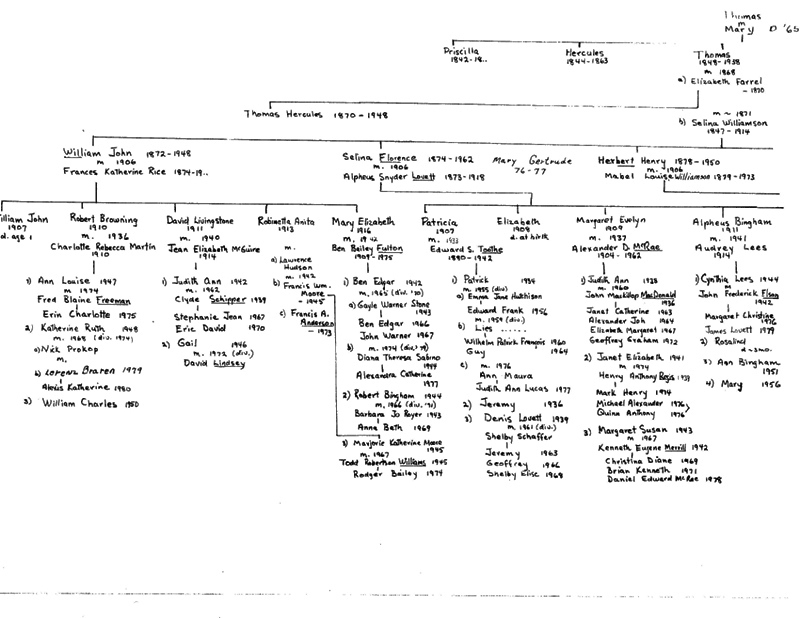
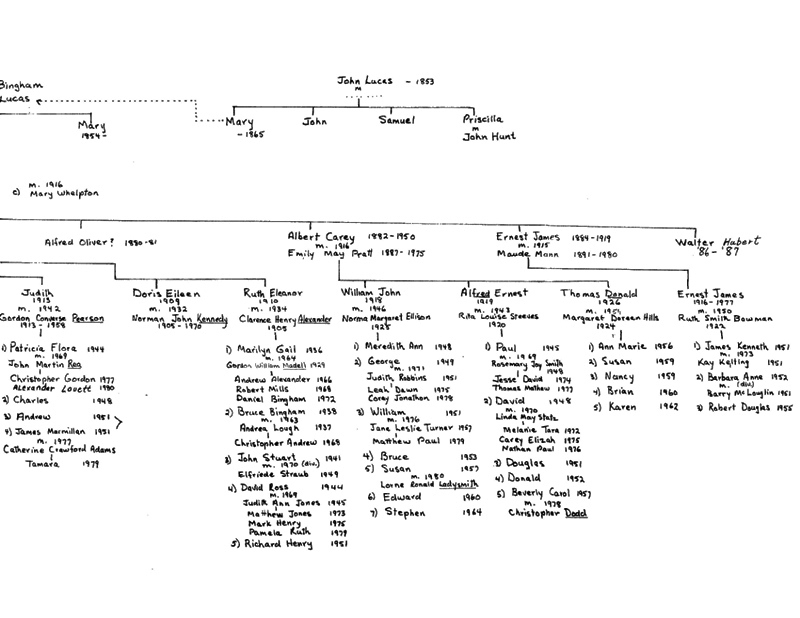

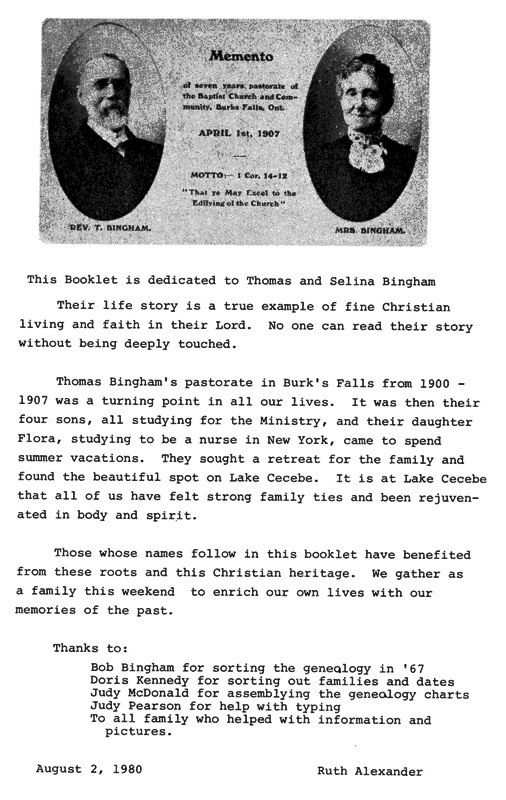


















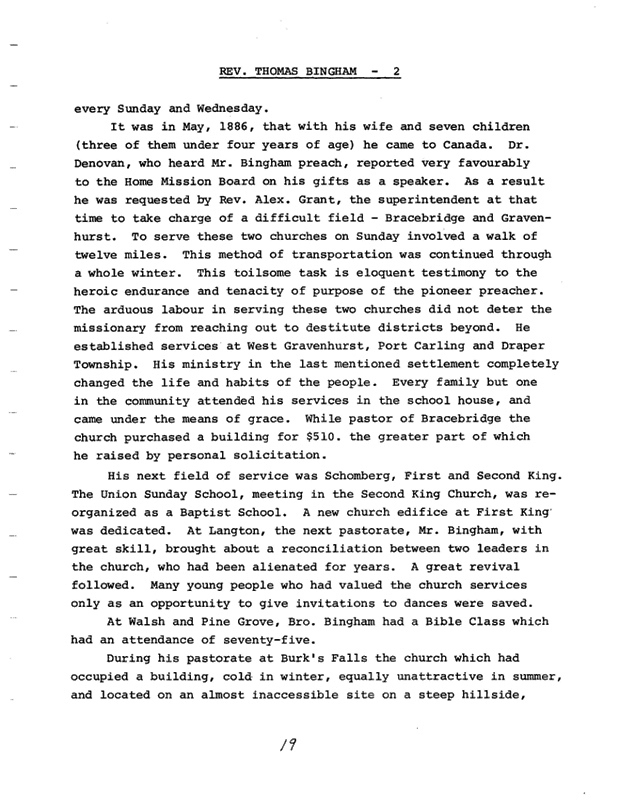





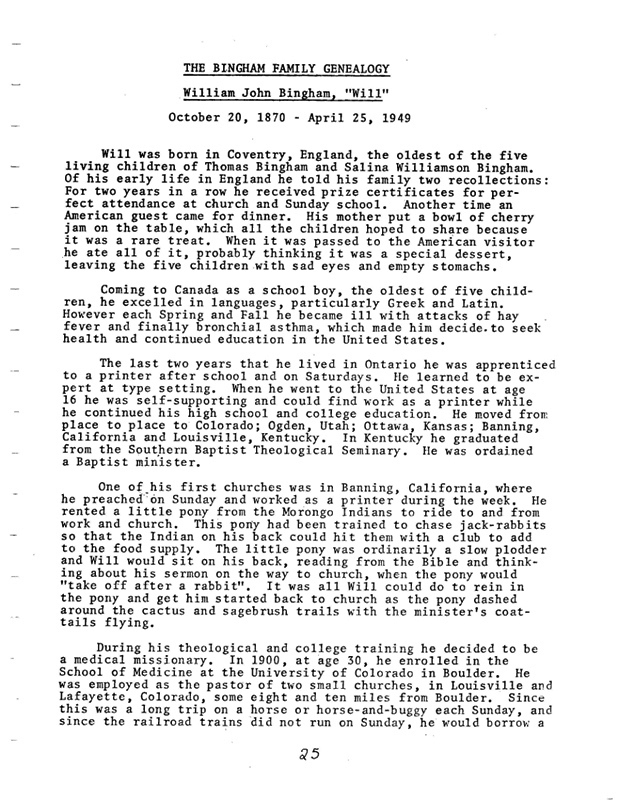
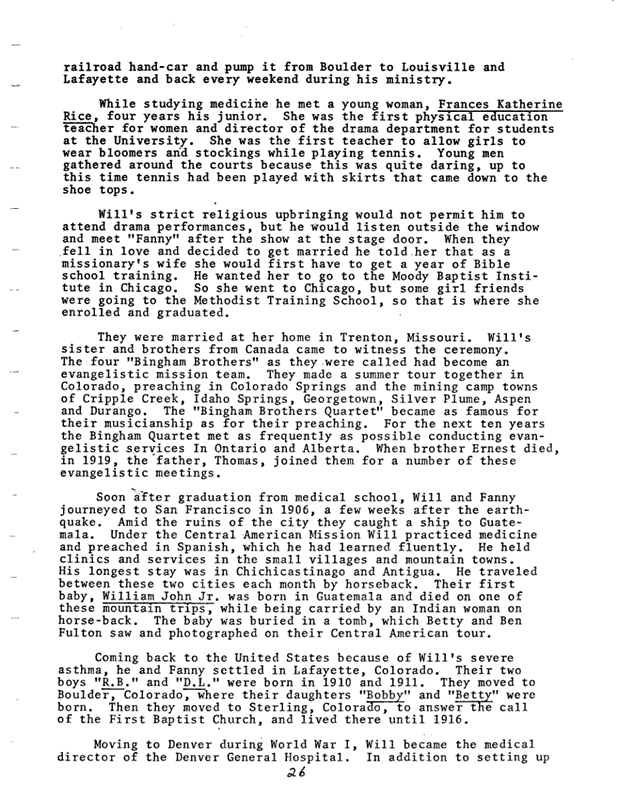

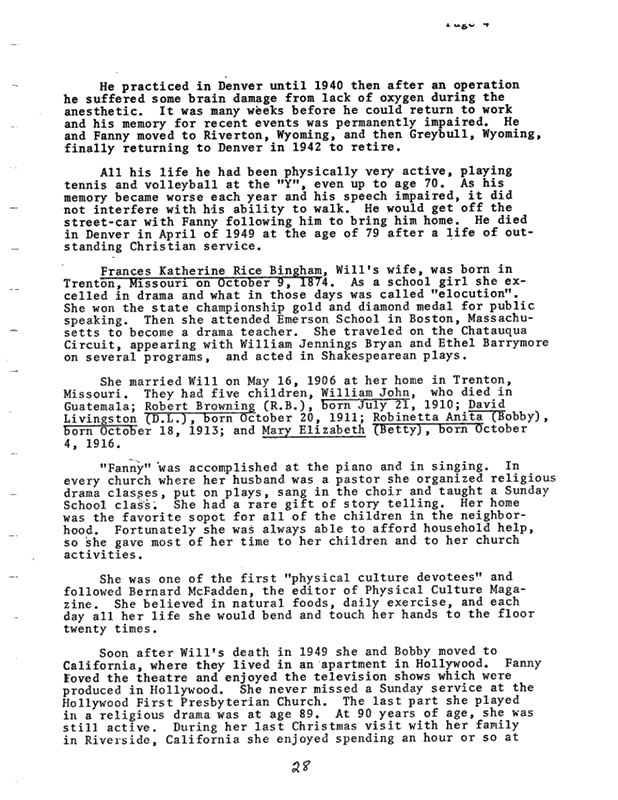
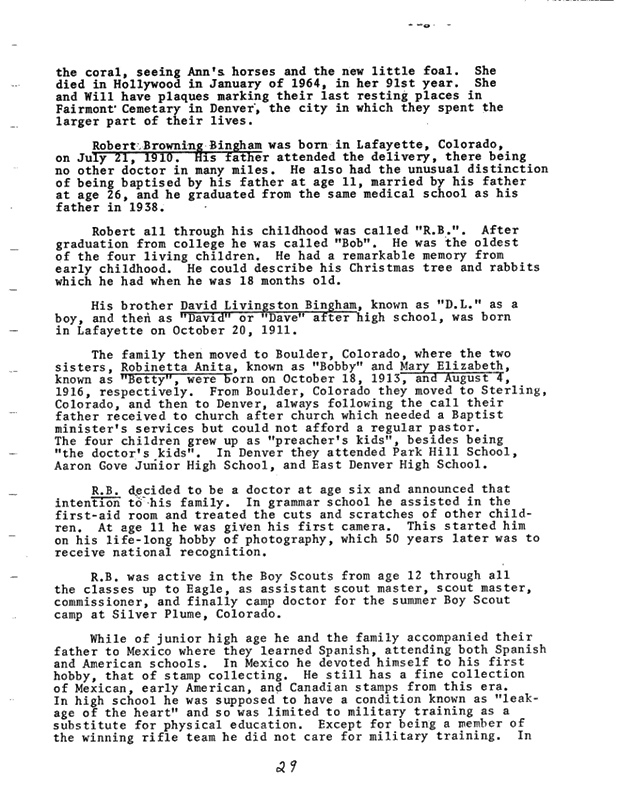
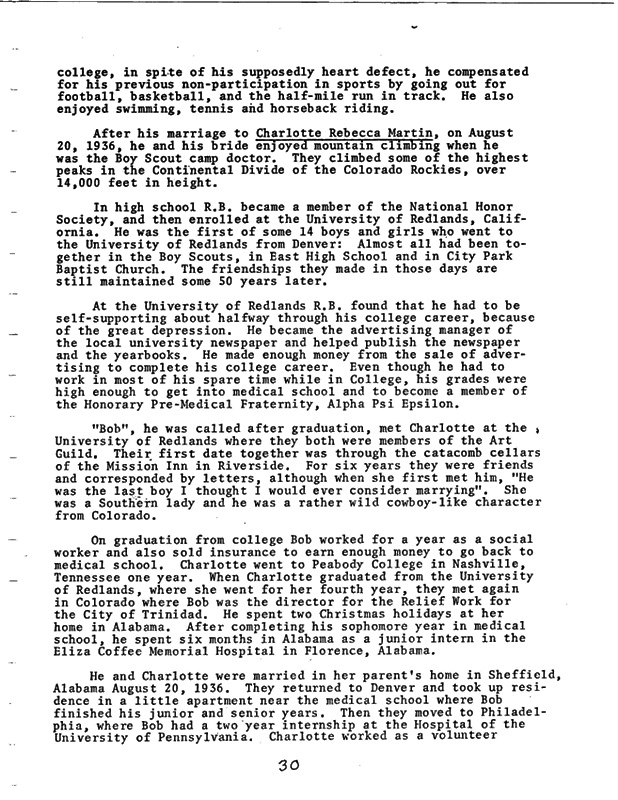

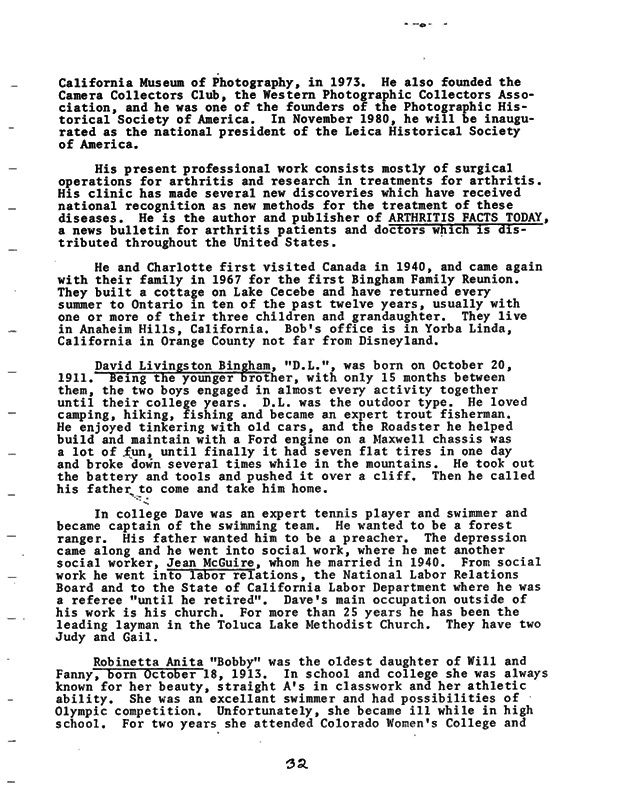
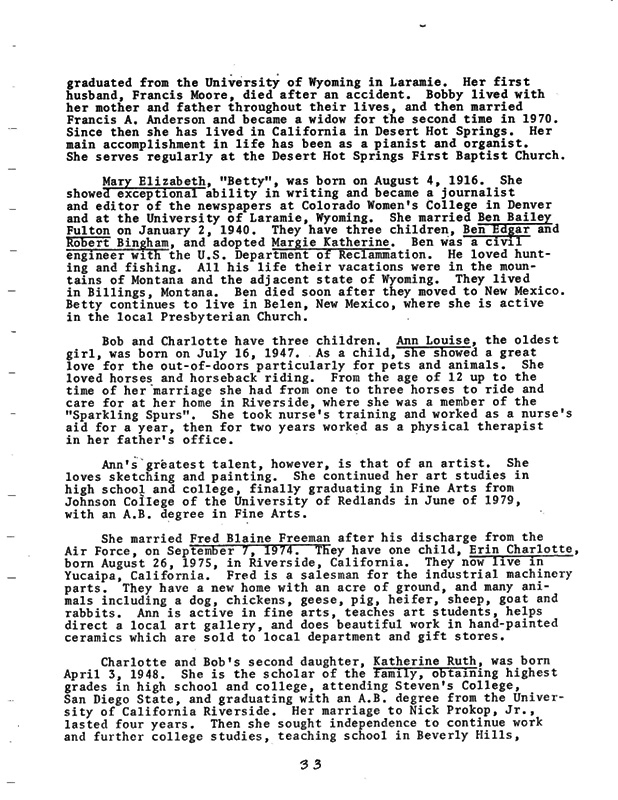

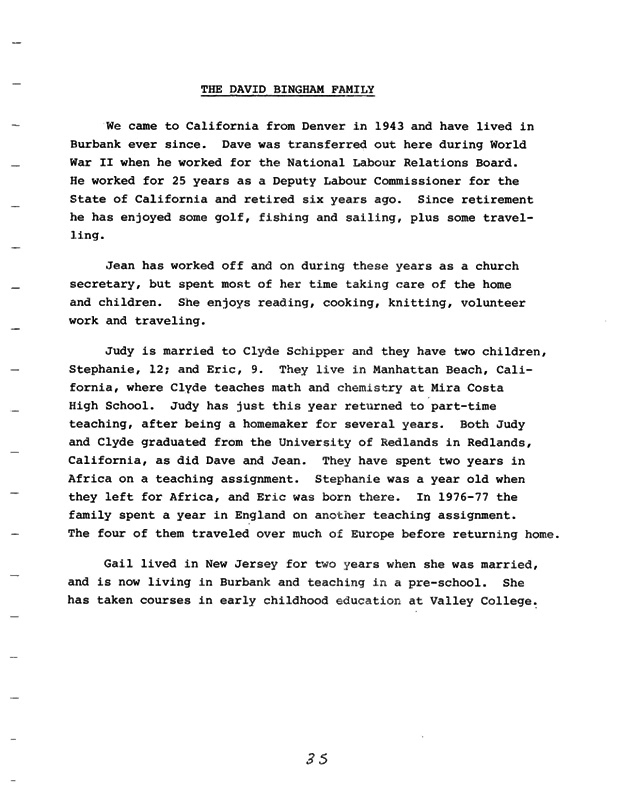
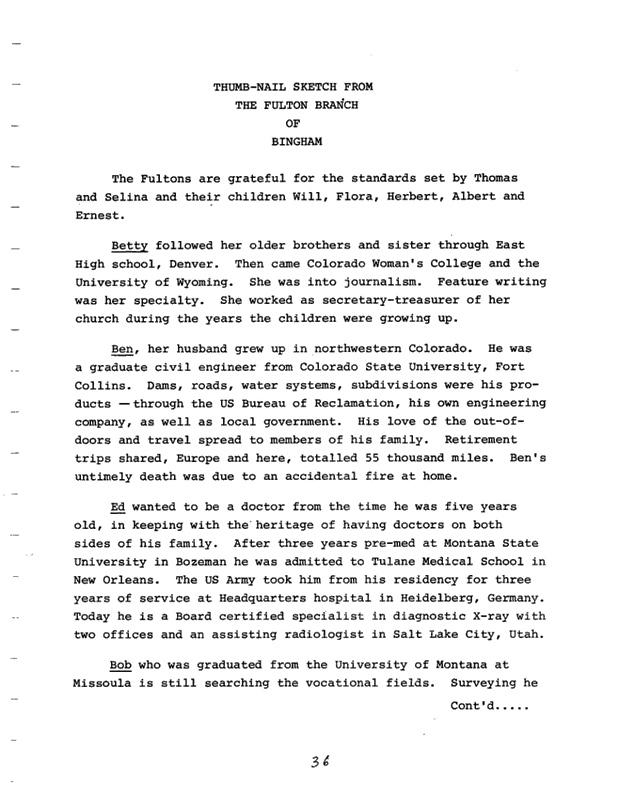
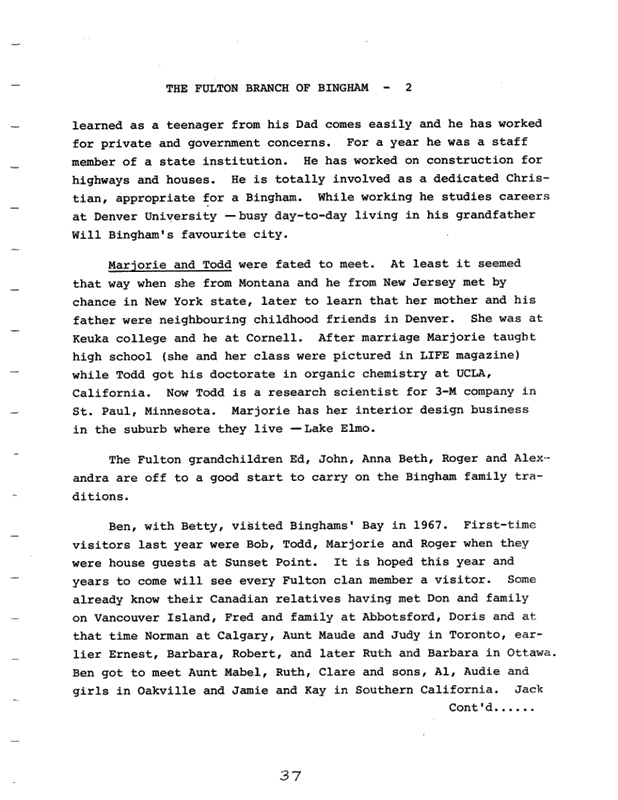
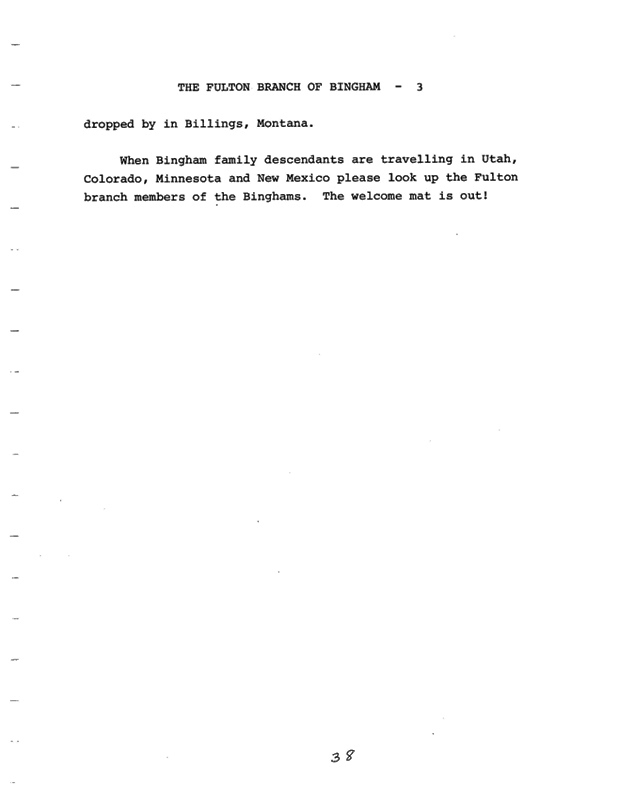
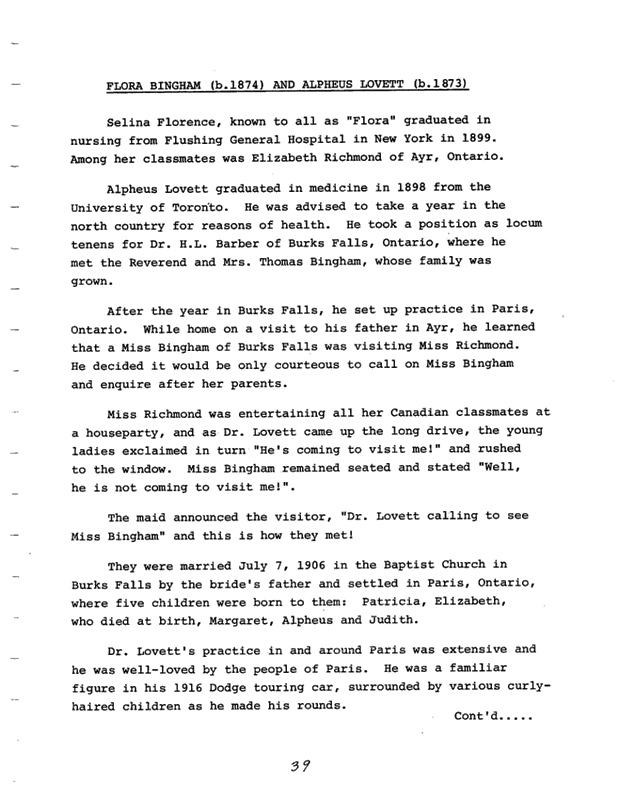
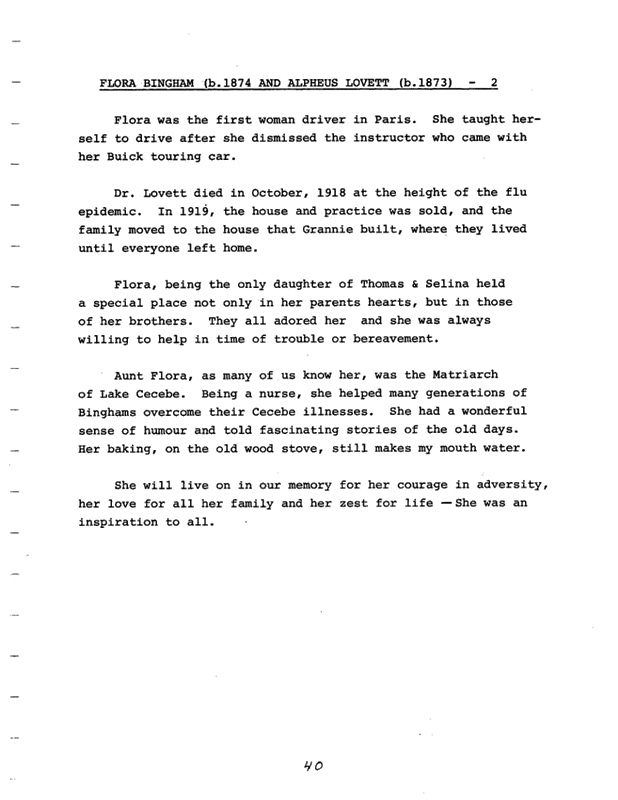

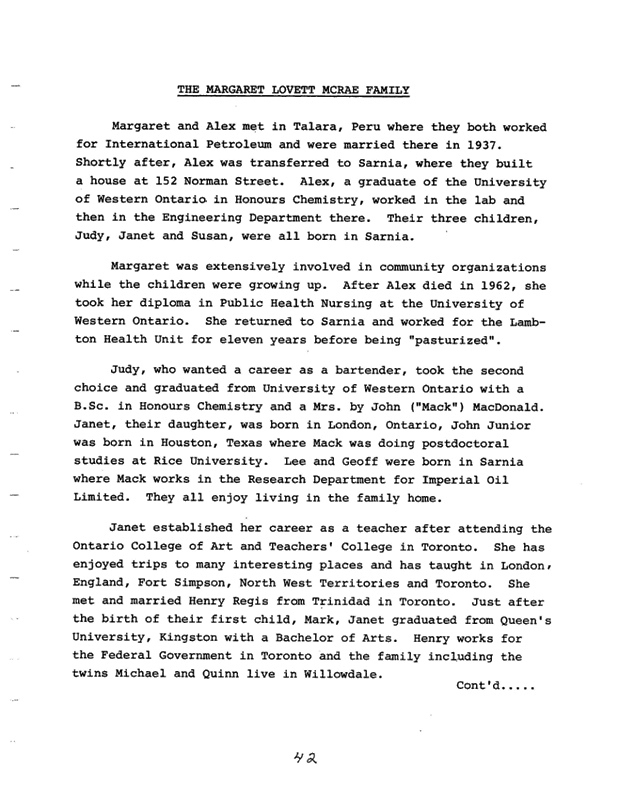
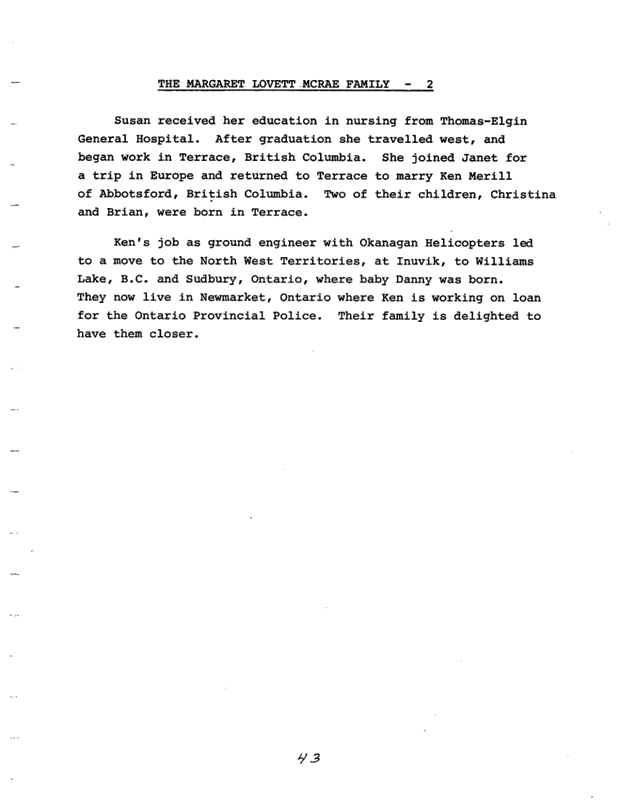

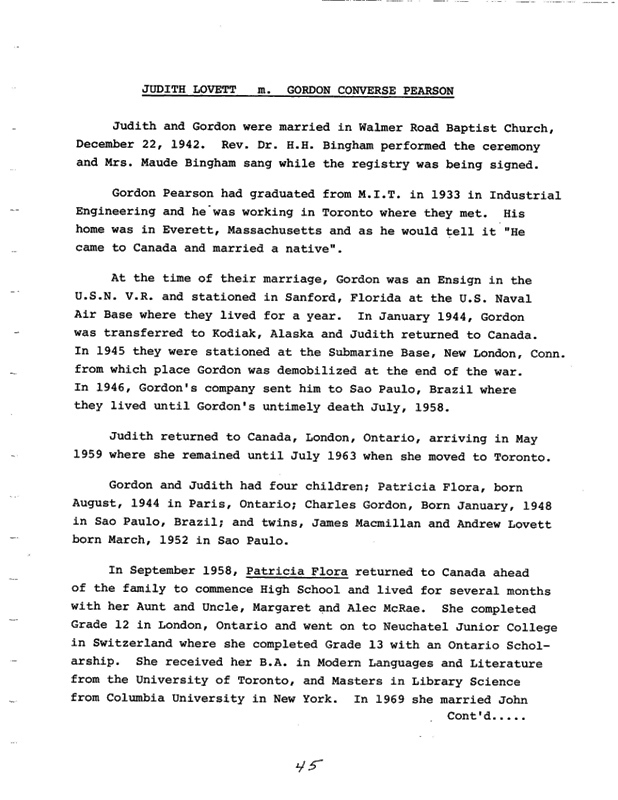

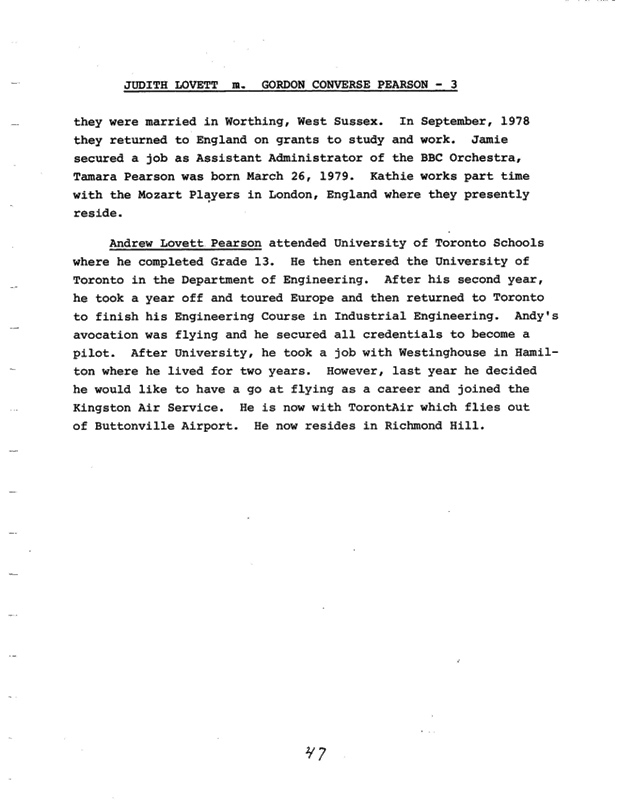
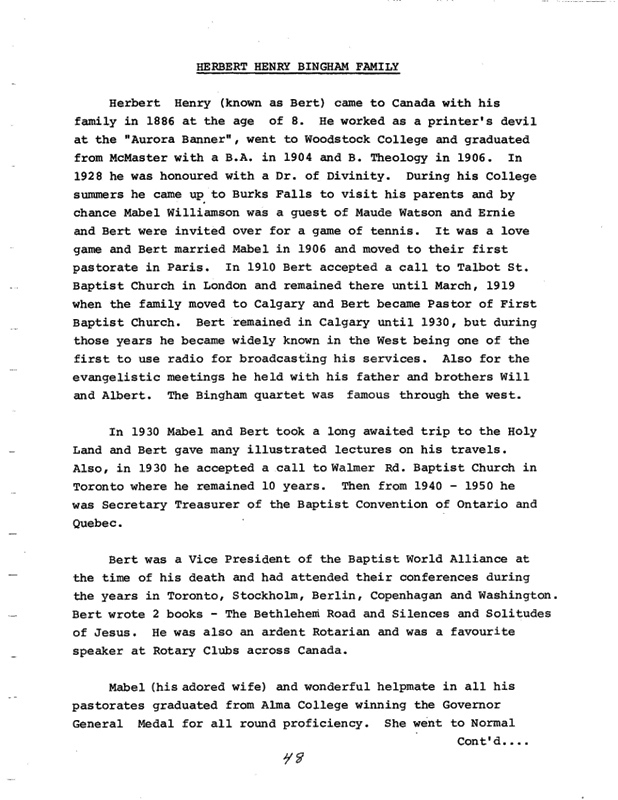

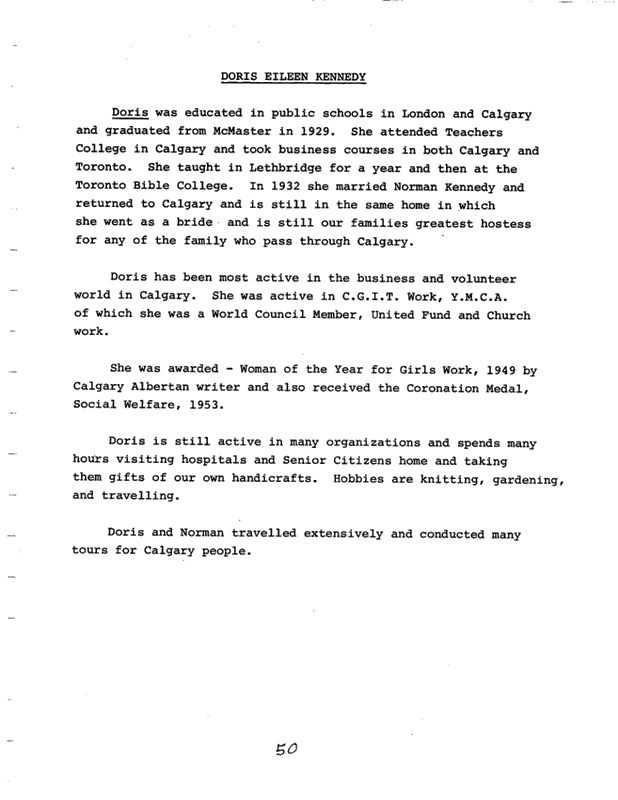
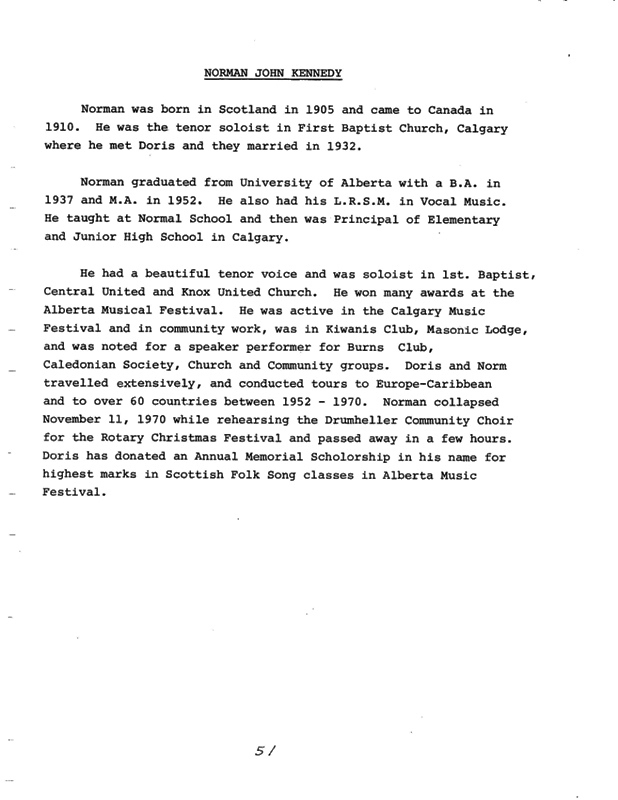
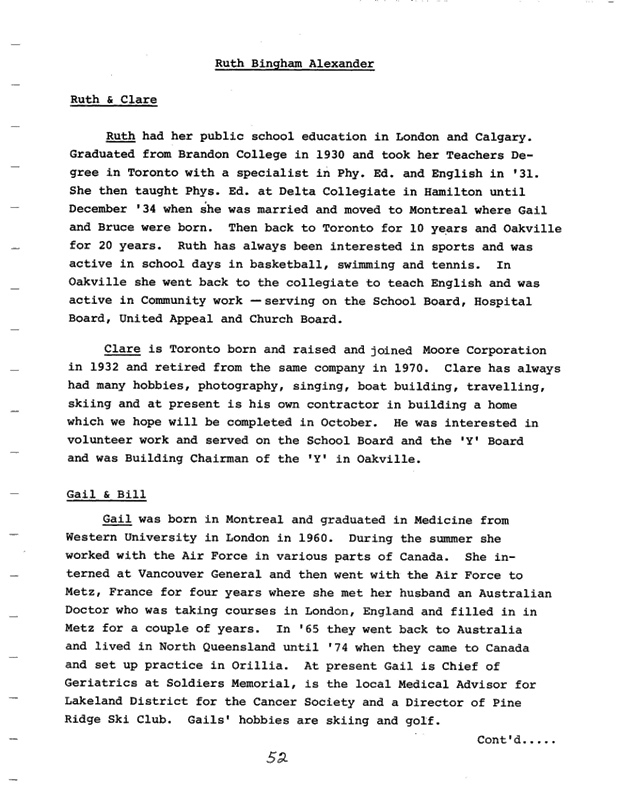

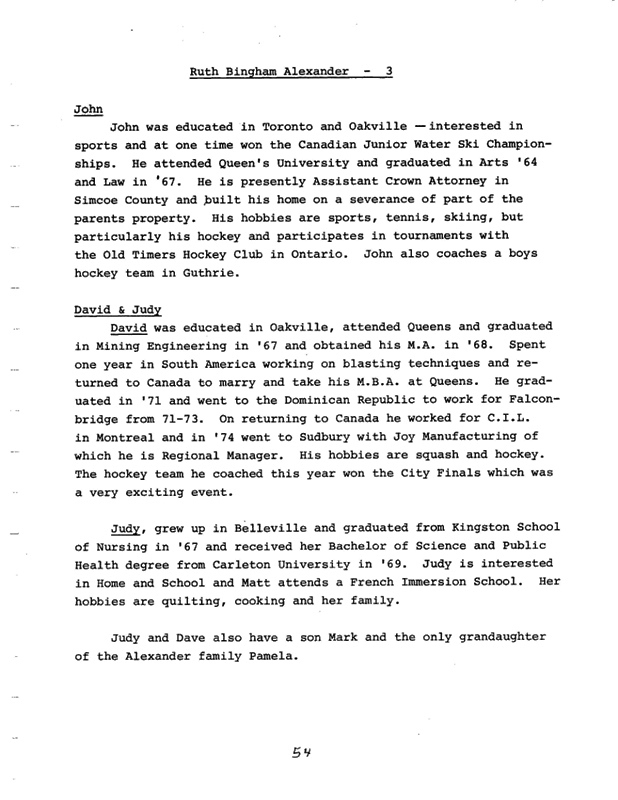
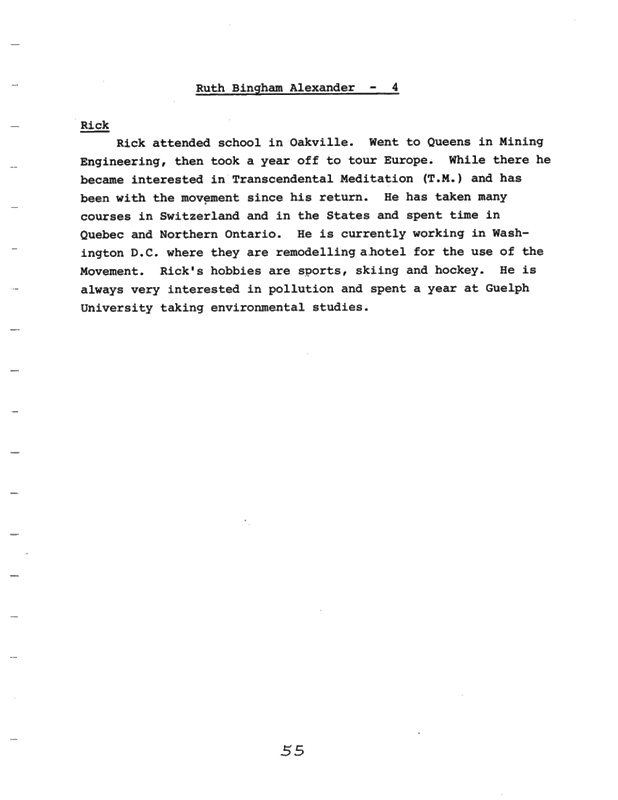



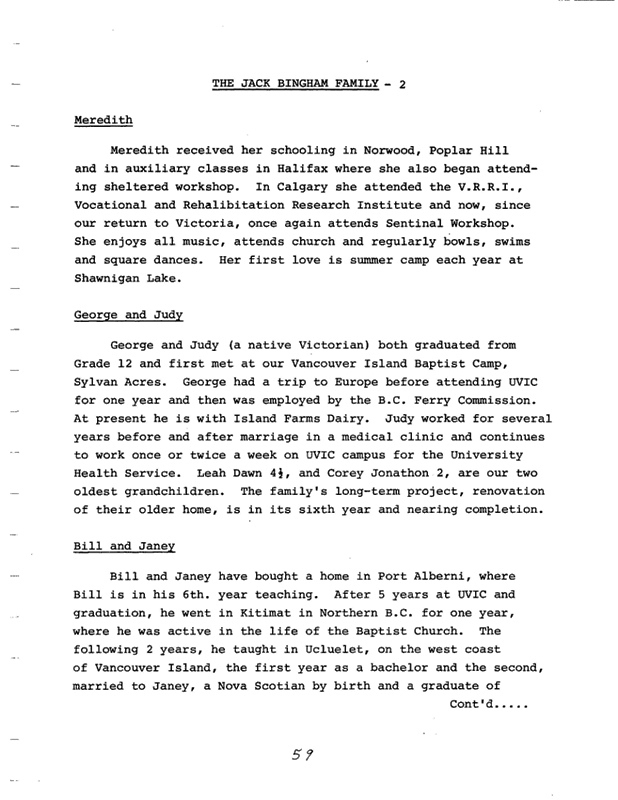
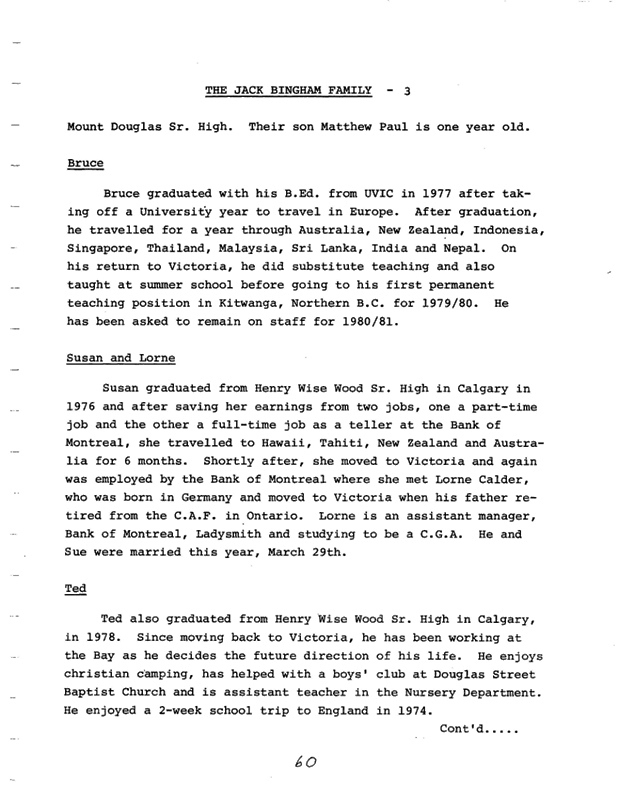
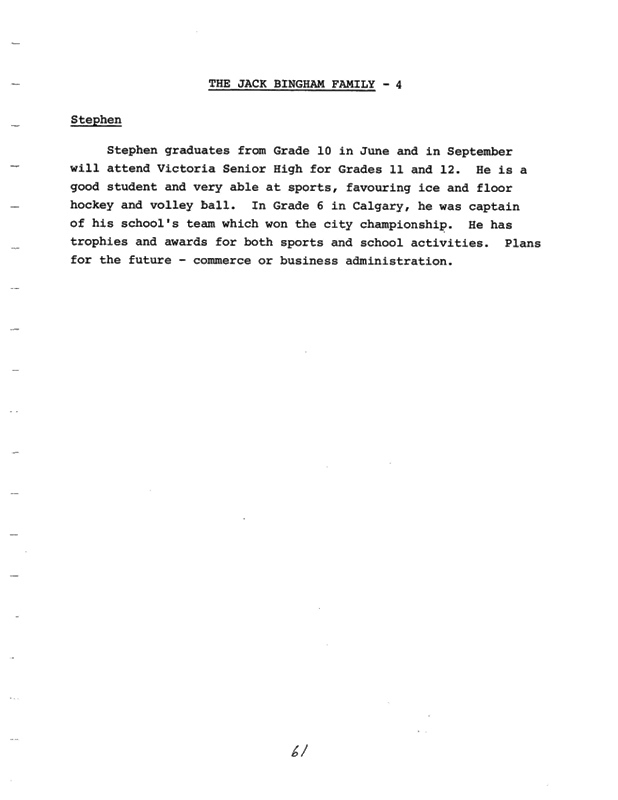
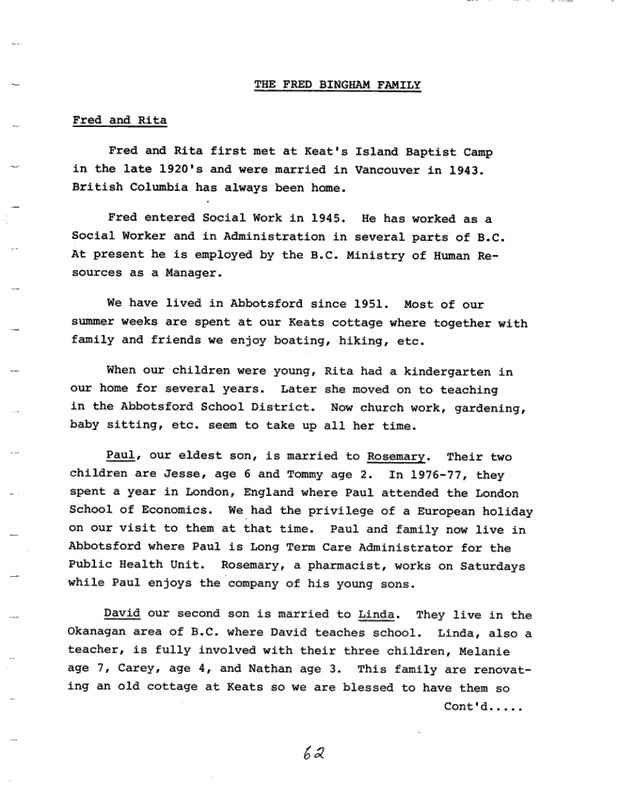


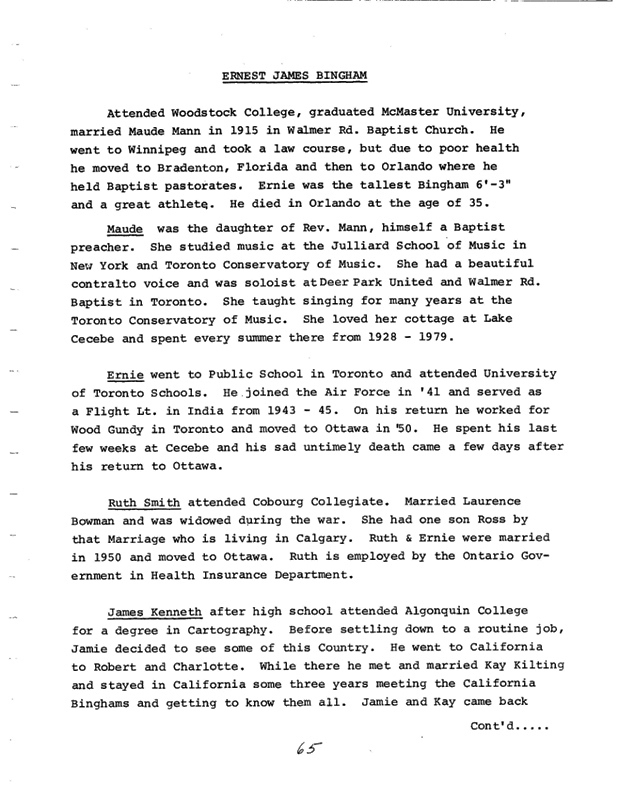
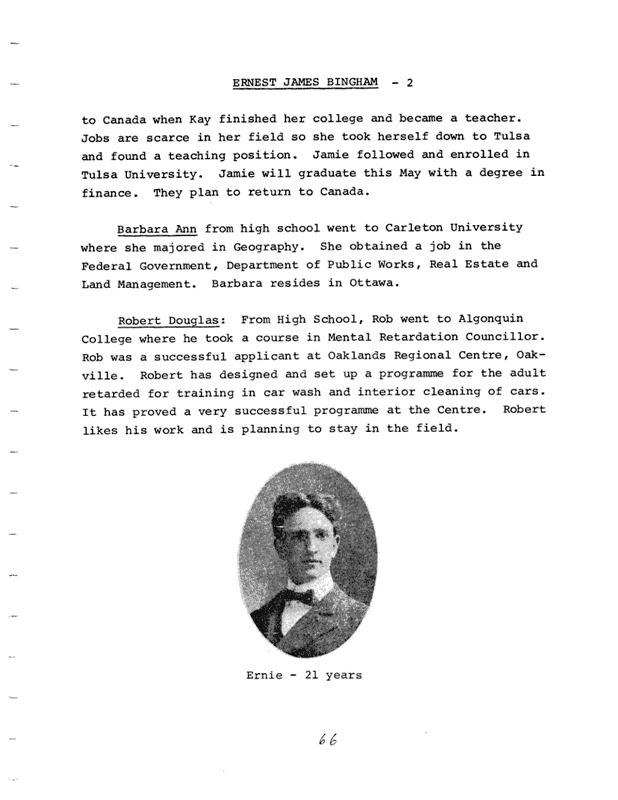
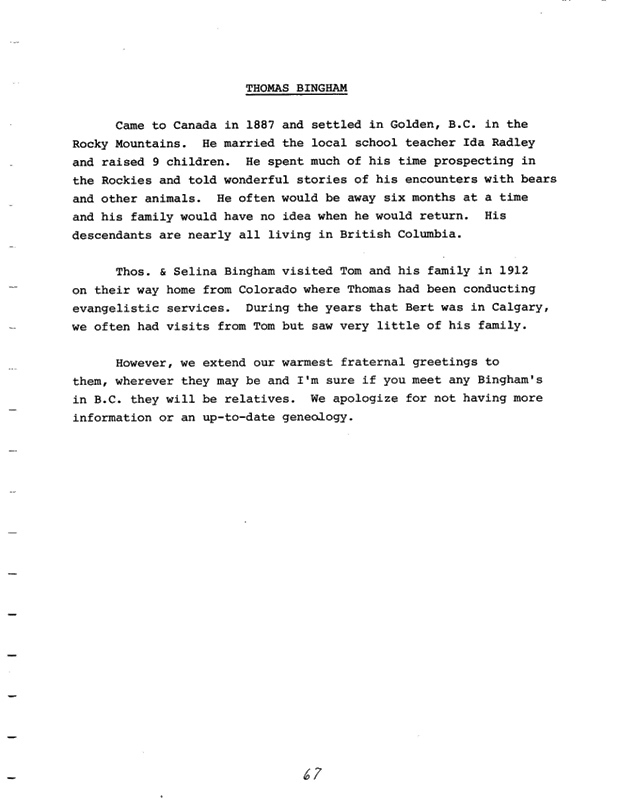
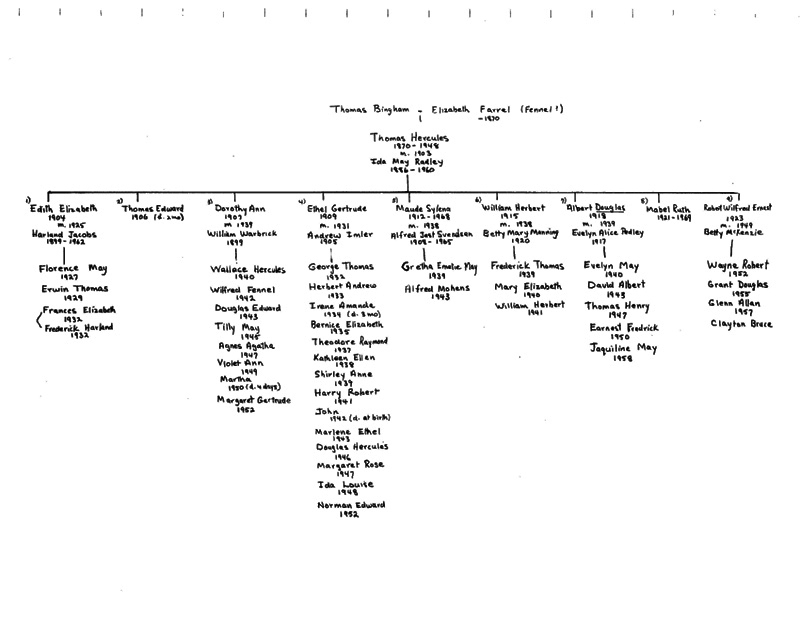

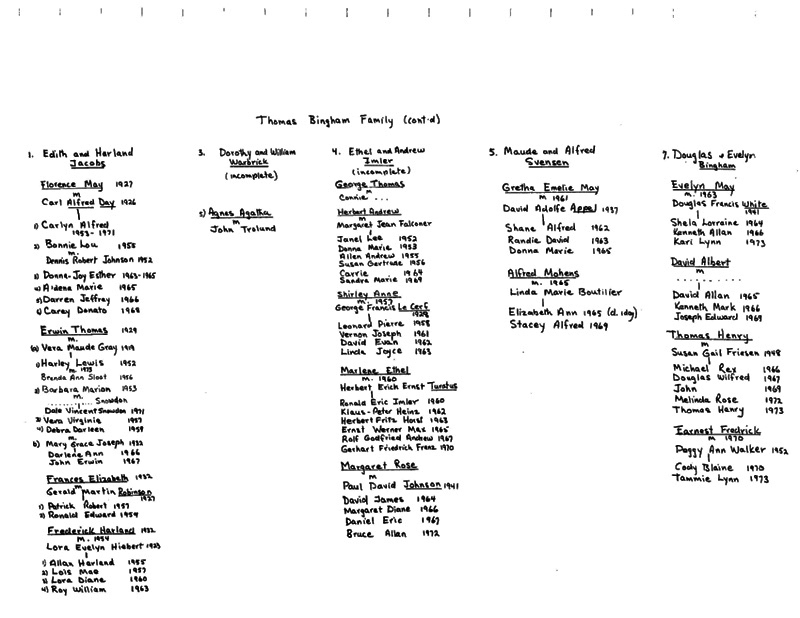
Note: Albert Bingham's wife May Bingham maiden name was Pratt-
English Roots of the Thomas Pratt
( c1817 – c1870 ) Family
by Bob Robblee and Paul Bingham
rrobblee@primus.ca
paulbingham@shaw.ca
Pratt Family Reunion – Olds, Alberta
July 29, 2006
Introduction
T
he family tree record of the Thomas Pratt family in Canada, developed and maintained by Bob Robblee has traditionally commenced with Thomas Pratt and his wife, Sophia, nee Pedgrift. It is known that Thomas and Sophia were married in 1841 in London England and came to Canada sometime within the next 5 years, as their oldest son, Charles C. Pratt was born in 1846 in Middlesex Ontario.As indicated on the record, Thomas and Sophia had three children: Lucy, born 1842, Charles, born 1846, and William born 1849. Thomas and Sophia remained in Ontario, and some families of subsequent generations have moved to other parts of Canada, primarily Alberta and British Columbia.
Although the Pratt family in Canada has been well documented for seven generations, little has been known about the family’s roots in England, before Thomas and Sophia made the decision to come to Canada.
Recently Bob and Paul have been looking into the English roots of the Pratt family: to date our findings are limited, however we would like to share what has been learned to date in the hope that other Pratts will find this information of interest, or may wish to join us in finding out more.
1. Information Sources
A. Family Letters
Some of the documentation concerning previous generations of the Pratt family has come from several letters to Thomas and his family in Canada from relatives who remained in England, and a letter from Thomas to family in England.
Bob Robblee received the letters from his father, who in turn got them from Bob Weaver (1917 – 2000) after a request to the family of Edith Weaver
(nee Pratt – 1886 – 1967)
The three letters are as follows:
Letter #1 – Daniel Pratt to Thomas Pratt – September 24, 1865
Daniel, living in Cuckfield Sussex England, wrote to his brother Thomas in Canada to advise that his wife had passed away the previous November. He provides some information on his 5 young children.
Letter # 2 – Thomas Pratt to Daniel Pratt – May 24, 1866
Thomas wrote to Daniel to express condolences regarding the death of Daniels wife. He also comments that their brother William has recently suffered the loss of both of his sons within 2 weeks.
Letter # 3 – Daniel Pratt to William Pratt – August 11, 1870
Daniel wrote to William Pratt (son of Thomas) to provide updates on the family in England. The letter indicates that Thomas has passed away.
These letters are included as Appendix 1
B. Record of John Adey Family
Much of the information on Pratt ancestors in England has come from a website developed by John Adey: "The Family Tree of John Adey of Painswick, Gloucestershire, England, from 1640". This site may be found at:
http://freespace.virgin.net/john.adey54/index.htm#TOC
The site focuses on Adey family members: the Pratt connection comes from the marriage of a William Pratt to one of the Adey daughters.
Although some of the information provided on this site is consistent with other family records available, not all of the details provided have been confirmed.
Information that has been taken directly from John Adey’s site is in italic print. Some editing has been done to reflect persons directly related to the Pratt family.
C. Internet Resources
Other sources used in collecting information on the Thomas Pratt family include a number of websites with genealogical information for persons from the United Kingdom. These sources are listed in the "Notes" section at the end of this paper.
2. Parents of Thomas Pratt (1817-1870)
The Adey website indicates that the parents of Thomas Pratt were Lucy Adey
(1778/1779 -) and William Pratt (1779 - ). Lucy was born in Painswick, Gloucestershire, and William was born in 1779 in Miserden, Gloucestershire, approximately 5 miles away from Painswick. Lucy and William were married on February 14, 1809 in Painswick.
Lucy was the daughter of Daniel and Margaret Adey (nee Clifford) and came from a family that had lived in the Painswick area of Gloucestershire since the 1640s.
Apart from his birth year and place of residence at the time of his marriage, there is no further information available on William Pratt.
3. Siblings of Thomas Pratt (1817 – 1870)
Lucy and William Pratt had six children including Thomas. The Pratt children included:
i. John Adey Pratt (1811 – 1867)
John Adey Pratt was baptized on October 6, 1811 in Painswick. He died on 4 Jan 1867 in Bristol. John was named after his uncle Rev John Adey.
John Adey Pratt attended Painswick Grammar School and was apprenticed to a tradesman in Painswick. He was taken to Painswick Independent Chapel by his mother. At age 20 he moved to Kingston-on-Thames and lived with a relative. In Kingston he began teaching in Sunday School, his first class consisting of chimney sweeps collected for the purpose, he also held prayer meetings in curious places such as a cow shed and Kingston Bridge.
In 1836 he moved to London, started a business on his own account and attended Southwark Chapel where Rev John Adey was minister. Both John and his brother Daniel were deacons at the church and they established a Sunday School where in 1868 five hundred scholars met for instruction. The Sunday School produced 8 or 9 ministers, several teachers and missionaries. On one occasion Rev John Adey was unable to travel 20 miles to preach so he sent John.
On 6th October 1950 he preached his first sermon at Kingswood Chapel, Bristol, he was invited back and on 31st March 1851 he began work as the minister in Bristol where he increased the congregation from 180 to 342.
He was one of the secretaries of the Bristol Auxiliary to the London Missionary Society, he was an advocate of the cause of total abstinence from intoxicating liquors and he was known as the children’s friend, there is a Sunday School Memorial to him in Arnos Vale.
The 1868 Congregational Year Book has a lengthy obituary for John, which also contains interesting information about the Adey Non- Conformist background.
In his letter of August 1870 (Letter #3), to Thomas Pratt in Canada, Daniel Pratt provides a short summary of John’s life, and his family:
"My brother John, who was an Independent Minister in the City of Bristol, died suddenly three years ago and more (?), in the midst of great usefulness, leaving a widow & several children. One of his daughters is married to a Baptist minister in the Royal Borough of Windsor; another is married & living in South America. His eldest son resides in Bristol, & the youngest at Adelaide in South Australia. The mother resides with friends, moving from one to another."
The Adey website records only one of John’s children: Catherine Adey Pratt (1841 – 10 September 1923)
ii. Lucy Ann Pratt (1814 -)
Lucy was born in Painswick, and baptized there on September 4, 1814.
In his letter of August, 1870, (Letter #3), Daniel mentions Lucy as Mrs. King, and indicates she is living in London:
"Your Aunts Sell and King (my sisters) are living in Leighton in Bedfordshire, & in London. They have both large families, & the young people are doing well."
iii. William Coolling Pratt (1816 – 1874)
William Coolling Pratt was baptized on June 30, 1816 in Painswick.
William was also a clergyman, and lived in Keynsham, near Bristol. Keynsham was a small village in Somerset, located 7 miles northwest of Bath and 6 miles southeast of Bristol.
In his letter of May 24, 1866, Thomas refers to the recent death of both of William’s sons, who apparently died within two weeks of each other:
" But it is of William I am now most thinking, called upon to mourn the loss of his two and only sons and in so short a time. I feel grieved for both parents in their great affliction. I was greatly struck by with the account of the death of the second son, Alfred, within a fortnight of his brother’s"
The last letter I received from England was from William in February where he speaks of his two sons as not being in haste to change their lives of single blessedness. He there took occasion to say he did not know of any of our family of whom he need be ashamed, whatever, & pain and pleasure remains for us from our families only sorrow can pertain to him at the untimely end of his two sons, for I consider the death of the young to be untimely….. I trust that the bereaved parents will receive strength from above to sustain them under their great affliction."
The deaths of these young men must have occurred after September 1865, since Daniel reports that the family is well in Letter #1:
"Brothers John & William have been here this summer, preaching & praying – talking and traveling. They and theirs are well, and doing well."
Four years later, Daniel again refers to this sad loss in his August 1870 letter (Letter # 3) to William Pratt:
"My brother William is a Baptist Minister, as you know, at Keynsham near Bristol. He has no children living, both having died of fever a few years ago to the great grief of their parents."
iv. Daniel Pratt (1818 – 1873)
Daniel Pratt was born in Painswick and baptized there on November 22, 1818 He died in Cuckfield, Sussex, in March 1873.
Daniel lived in Cuckfield Sussex for at least nineteen years: it is not known when he moved there, however "Kelly's Post Office Directory of Essex, Herts, Middlesex, Kent, Surrey and Sussex, 1867" lists, as a resident of Cuckfield,
"Pratt Mr. Daniel, Croft Cottage. "
The August 1870 letter from Daniel to William Pratt in Canada indicated that he was one of the proprietors of "The Christian World", which he describes as "a journal with a splendid circulation"
Daniels oldest son,, Cromwell Daniel Pratt, was born in 1849. Cromwell died on March 1, 1854 in Croft Cottage, Cuckfield Sussex. The Times (London) for Saturday 4th March 1854 carried the following death announcement:
"On Wednesday 1st inst at Croft Cottage, Cuckfield, Sussex - Cromwell Daniel, eldest son of Mr. Daniel Pratt in his 5th year."
In his letter to Thomas of September, 1865 (Letter #1), Daniel notes that his wife passed away in November 1864, and that he has five children:
"My two boys – 13 & 14 years of age – are from home at school. I hope they are getting on well with their studies. My eldest daughter 17, and the two youngest girls 6 and 4 are at home. They are good girls and I hope to receive from them comfort and succour."
In his letter of August 1870, (Letter # 3), Daniel refers to a wife, so it is apparent he has remarried. He also provides an update on his 5 children:
"My eldest daughter & my youngest are residing with me in Sussex, 40 miles from the great London, where your own father paid me a visit in 1862. My eldest son, in his 20th year, is articled to an Architect and Surveyor in London. My second son, in his 19th year, is articled to a Civil Engineer, close to the famous Old Abbey and the Parliament Houses. My two daughters (aged 14 & 11) are in School in Hertfordshire, 60 miles from home."
Daniel also includes some information about himself in this letter:
"With reference to myself, I have but little to say. I was asked to represent the London Sunday School Union at the conference in New York. The gathering was postponed owing to the terrible war which has broken out between France and Germany. Had I crossed the Atlantic, I should have paid you a visit in Canada. "
From his comments about Thomas and Sophia in this letter, it is clear that Daniel had very positive feelings about his relatives in Canada:
"Mr. Denton said he thought one of you was likely to visit the old country. If so you will receive from your dear Father’s relatives a very hearty welcome."
"I must conclude merely saying that my family join me in love to you and the other members of your family, not forgetting your widowed mother. I recollect her well when she was first married & sailed with your father to the land of their adoption"
v. Catherine (Kate) Pratt
Catherine Pratt was baptized in Painswick on November 22, 1821.
Although she is not recorded in the Adey family history, Daniel refers to his sister Kate in his letter of September, 1965 (Letter #1):
"Mr. Sell (?) & Mr. King, I have no doubt, posted you up with all general family news. They are capital correspondents. Trottie King, Sister Kate’s eldest daughter, is on a visit to us. She is a lively, intelligent girl – short, sharp & smart. We are quite cheered up by her presence & sunny face."
4. Sophia Pedrift – Spouse of Thomas Pratt
Sophia Pedgrift was baptized on February 14, 1818 at Beccles, Suffolk. Beccles was a small village approximately 30 miles north east of Ipswich, 12 miles south east of Norwich and 10 miles from the coastal town of Lowestoft.
Sophia married Thomas Pratt on May 7, 1841 in London, and they emigrated to Canada shortly after.
5. Ancestors of Thomas Pratt
The Adey website provides information on five generations of the family of his mother, Lucy Pratt (nee Adey) prior to the birth of Thomas Pratt (1817-1870). The information is not complete, and this summary does not include all information on Adey family members. As noted, the Adey family lived in Painswick from the time of the first John Adey, born about 1640, at least until the birth of Catherine (Kate) Pratt in 1821.
a. First Generation: John Adey (c 1640 –after 1697)
Family records now lost say that John was possibly the son or grandson of a Roundhead soldier. He was born at the time that the struggle between the King and Parliament began and he lived through the Civil War in 1642, the restoration of the monarchy in 1660, the plague outbreak of 1665 and the Gloucester smallpox outbreak of 1687. Family tradition says that he was the 12th wealthiest in Painswick in 1685. According to "Glimpses of the history of Painswick" by F. A. Hyett in 1700 there were 186 families in Painswick.
John obtained Ifold (now Highfold) from widow Cooke some time after 1684. Ifold is also the site of a Roman villa. John Ady of Ifold was an overseer of the poor for Edge Tithing in 1686/1687. A hearth tax receipt for 1686 was still with Edward Henry Adey c 1950 but unfortunately cannot be found at present. He was a constable in 1695 and churchwarden in 1697. His signature or his sons is on the inspection of the parish accounts 24th April 1701. Stone from his estate was used in the building of the Congregationalist Chapel in 1705.
John Adey had a son, also named John Adey, who was born about 1660. He died about 1734.
b. Second Generation: John Adey (c1660 – c 1734)
A John Ady married Mary Weaver on 29th November 1700 in Dursley and a John Ady (rugger) married Margary Cartar on 29th august 1683 in Uley.
According to family records in 1713 John was an overseer for Stroud End tithing and held an estate called Winns, which may have been near Washbrook in 1713. In "A Cotteswold Manor being the History of Painswick", Welbore St. Clair Baddeley says that John sold Byfield House and other property in Bisley Street to Hester Knight in 1728 and that he (or possibly his father) rebuilt Herrings Farm, henceforth known as Adeys Farm (even to c 1800) which was sold to Charles Hyett, a Gloucester solicitor of Painswick in 1736 and from a non conformist family.
Charles Hyett pulled down the farm and built the central portion of Painswick House, though older buildings remain on the north. In 1856 William Henry Hyett purchase another part of Ifold Farm but probably the Adey's had left Ifold by then. Later the Hyett family built the Rococo gardens on land adjoining Painswick House.
John Adey had three children: John, Richard and Samuel.
c. Third Generation: John Adey (1686 – 1758)
John Adey (John, John) was born in 1686 in Painswick. He died in 1758, and was buried in St Mary's Churchyard, Painswick.
According to family tradition John was an overseer in 1744. In 1754 John and Judith appear before the Customary Court of the Manor concerning rent owed to them by Edward Palling (an Edward Palling of Brookhouse had died in 1751) for 5 acres arable at Edge, 3 acres pastures in bottom at Ifold, 3 1/2 acres arable in Church Bush at Ifold, 1 acre pasture called Rye at Edge (last to Thomas King). He aided in the erection of Painswick Presbyterian (now Congregational) Church in 1703. John was granted administration of his brother Richards estate in 1739 and his occupation at that time is given as husbandman.
John is buried in St Mary's Churchyard, Painswick. The inscription is now almost completely unreadable but his surname appears to be spelt either Ady or Adye.
John married Judith King on 26 Dec 1710 in Brookthorpe. Judith was born in 1692/1693 in Painswick. She died in 1785.
According to family records Judith was the last Adey to live regularly at Ifold.
John and Judith had eight children: Sarah (1712-1787), John (1713 -?), Mary (1716/17 -?) Richard (1718/1719 – 1776), Thomas () Jane (? – 1748)) Elizabeth (1724/1725 – 1750)) and Daniel (1730/1737 – 1803)
d. Fourth Generation: Daniel Adey ( 1730/1737 – 1803)
Daniel Adey (John, John, John) was born in 1730/1737, and died in 1803. He was buried in St Mary's Churchyard, Painswick.
According to his tombstone Daniel was a yeoman and he was born in 1731 but according to his marriage license he was born in 1737.According to the Poll Book for the Election of a Knight of the Shire for the County of Gloucester in 1776 Daniel Ady occupied tithes in Painswick owed by Thomas Frankis. He held Cambridges & Bonds estates Stroud End from 1782 to 1798.
The Universal British Directory of 1791 shows Daniel Adey, Yeoman, as one of the principal inhabitants for Painswick. According to family records in his later years Daniel lived at Greenhouse, near Bulls Cross.
According to his will Daniel was a Maltster, he left his property at Greenhouse in Painswick to his wife Margaret for the term of her natural life and then to his son John. His goods, chattles and personal estate he left to Thomas Stanley to hold in trust to invest and provide an income for his wife for her lifetime and then to be passed to his children. His son John was the sole executor of his will. The witnesses included Cornelius Winter, minister of the Congregational Chapel. Daniel was unable to sign his name and the will bears his mark and an impression on sealing wax.
Daniel married Margaret Clifford on 14 Oct 1762 in Kings Stanley, Gloucestershire. Margaret was born in 1737/1740. She died in 1821.
The Clifford family originated in Frampton-on-Severn immediately after the Norman conquest. In 1081 the manor was granted to Drogo fitz Ponz, grandson of Richard, Duke of Normandy. Drogos nephew Walter fitz Ponz took the name Clifford from his own lordship of Clifford in Herefordshire before his death in about 1190. In 1684 John Clifford, a Puritan and Parliamentary supporter, died leaving no male children. The estates descended through the female line with husbands sometimes assuming the surname of Clifford.
Walter Clifford was one of the Domesday Commissioners responsible for collecting information for the Domesday Book.
Margaret came from Leonard Stanley. According to her tombstone she was born in 1738 but according to her marriage license she was born in 1740. She was the daughter of John and Jane Clifford.
Daniel and Margaret had the following children: John Adey, Daniel Adey, Winifred Adey, Thomas Adey (1771 – 1839), Frances Adey (1771/1772 – 1820) Elizabeth Adey (1774 -), Lucy Adey (1778/1779 -),, Ann Adey ( 1779/1780 -)
e. Fifth Generation: Lucy Adey (1778/1779 - )
Lucy Adey (Daniel, John, John, John) was born in 1778/1779 and married 1778/1779. William Pratt on 14 Feb 1809 in Painswick.
Lucy and William were the parents of John Adey Pratt, Lucy Ann Pratt, Daniel Pratt, William Coolling Pratt, and Thomas Pratt.
5. Geographical/Historical References
a. Painswick
Painswick, the home of the Adey family and the apparent birthplace of Thomas Pratt, is located in the county of Gloustershire, England, approximately 90 miles west of London. The nearest large city is Gloucester, which is 17 miles northeast, and Bristol is 35 miles to the southeast
Painswick was originally called Wycke or Wykeham and the name changed to Wyke Pagani around 1150. The Domesday book recorded 66 male inhabitants. The Painswick wool trade was first mentioned in the mid 15th Century.
During the civil war, King Charles stayed at Painswick on the night of 9 August 1643, en route to Gloucester to commence a siege of the city. On 5 September 1643, the King, and his army stayed overnight at Painswick, having left Gloucester when news reached him that an army led by Lord Essex was near Cheltenham. The King's men passed a miserable night at British Camp, Painswick Hill, the weather being stormy with heavy rain.
The town is known as "The Queen of the Cotswolds" mainly due to its fine buildings, many of which are made of pale grey limestone. These are a reflection of the town's former prosperity during 300 years of activity in the cloth industry.
The population of the town in 1700 was listed as 186 families, and the total number of persons has been recorded as 3,150 in 1801, 4,044 in 1821, and 3,734 in 1841. In the 1900s, the population remained constant at about 2,800 people, however change makes it difficult to compare current numbers to previous centuries.
The Parish Church in Painswick is St. Mary's Church
. The church is renowned for its churchyard, with its 99 yew trees, most of which are approximately 200 years old. The oldest part of the church, St. Peter's chapel, dates from 1377. The North aisle was added later, and the Nave and Tower built towards the end of the 15th century. The spire was added in 1632.b. English Civil War
The family story is that John Adey (First Generation – c 1640) was the son or grandson of a "Roundhead". The "Roundheads" was the nickname given to supporters of the Parliamentary cause, and Oliver Cromwell, in the English Civil War. It is know that Painswick was an area sympathetic to Parliament against the King.
During the civil war, King Charles stayed at Painswick on the night of 9 August 1643, en route to Gloucester to commence a siege of the city. On 5 September 1643, the King, and his army stayed overnight at Painswick, having left Gloucester when news reached him that an army led by Lord Essex was near Cheltenham. The King's men passed a miserable night at British Camp, Painswick Hill, the weather being stormy with heavy rain.
In 1644, St. Mary’s Church, Painswick, was occupied by the Parliamentarians, and severe fighting broke out when the Royalists advanced against Painswick. The church was damaged by fire, and the outer walls are still marked with bullet and cannon holes.
Although there is no evidence that the Pratt family supported Parliament against King Charles, it is interesting that Thomas Pratt’s brother, Daniel, named one of his sons
Cromwell.
c. Non-Conformists
The Adey website indicates that the Adey family had been "non conformists" for 200 years. Also known as dissenters, non conformists in England in the 18th and 19th centuries included a wide range of protestant groups that did not accept the conventions rules or traditions of the Anglican church. Presbyterians, Baptists, Congregationalists, Puritans and Methodists were all considered to be non-conformists.
6. Areas for Further Study
To date, the birth record of Thomas Pratt has not been located. Given the birth dates of his siblings, he could have been born between Lucy and William or between William and Daniel. It is also possible that he was adopted or a half brother.
No information is currently available on the family of Sophia Pedgrift.
Thomas Pratt was married in London in 1841 at the age of 24 – no information is currently available regarding his occupation while he was in England, or whether he lived in London.
The date that Thomas and Sophia left England and moved to Canada is not known – it occurred between the date of their marriage in 1841, and the birth of their second child, Charles, in 1846.
The dates of death of Thomas Pratt and Sophia Pratt are also not known. Their son, Charles Pratt, in a life insurance policy he took out in 1892, states that his parents both died at the age of 54.
Notes:
1. Marriage of Thomas Pratt and Sophia Pedgrift – The approximate date (Spring 1841) and the location (London) of the marriage has been confirmed by the "Free Birth Marriage Death Index" website.
http://freebmd.rootsweb.com/cgi/search.pl
2. Date and place of death for Daniel Pratt is registered at:
http://freebmd.rootsweb.com/cgi/search.pl
3. Reference to Daniel Pratt as a resident of Cuckfield in 1867 is at:
http://steve.pickthall.users.btopenworld.com/ssx1867/cuckfield1867.html
4. Information about Painswick and reference to it as "Queen of
the Cotswolds":http://www.cotswolds.info/places/painswick.shtml
APPENDIX 1
Letter #1 – Daniel Pratt to Thomas Pratt – September 24, 1865
Letter # 2 – Thomas Pratt to Daniel Pratt – May 24, 1866
Letter # 3 – Daniel Pratt to William Pratt – August 11, 1870
APPENDIX 2
Reverend John Adey (1793 – 1869)
A number of the Adeys had been clergymen – one of the more famous was Rev. John Adey (1793 – 1869), who was a nephew of Lucy Pratt, and a cousin of John, Lucy Ann, Daniel, William and Thomas. The Adey website lists a number of his accomplishments, and notes that Daniel Pratt (brother of Thomas Pratt) presided over his retirement recognition:
The British Library lists a number of books published by John Adey including
The Eleventh Hour (1835, 46 pages, published by Ward & Co), Hymns for Public
Worship (1845, published by E F Gooch of London), Hymns original and selected
(1831, published by Westley & Davies of London), The Night Cometh (1858, 16
pages, published by Ward & Co), Puritan-Gems (1850) and The Convert From Popery
(1851, 32 pages, published by Snow of London).
John was a Congregationalist (according to his obituary the Adey family had been
non conformists for more than 200 years) he was born in Painswick and as a boy
he often accompanied the Rev Cornelius Winter in his village labours and his
preaching visits to the villages around Painswickodist
While in Gloucester John was a drapers assistant, later he was engaged in
business in Winslow, Buckinghamshire and spent his leisure time as an itinerant
preacher. On Sundays he visited different villages in the neighbourhood and
began work in Great Horwood where he founded a Sunday School for children that
he found on the street. He found that adults also required instruction, he
gathered them together and found friends to speak to them. On one occasion his
friend did not arrive and so John preached his first sermon. Shortly after this
he gave up his business interests, moved to Great Horwood and devoted himself
full time to his preaching. In 1820 he was ordained after studying under Dr
William Harris of Kingston, Surrey, who became a tutor at Ho
xton Academy.
In 1830 he moved to Ramsgate, Kent (where he succeeded George Townsend).
While in Ramsgate he often used to visit London where he preached at Surrey
Chapel. This church still has a copy of his portrait signed "I am, yours truly,
John Adey".
John preached to North Sea Fisherman in Bethel and was London Missionary
Society director from 1832 to 1855. He was associated with continental work of
the Sunday School Union, a hymn writer and phamphleteer, also a very early
advocate (possibly 2nd) of early closing of shops.
The Times on 2nd November 1836 featured a lengthy editorial/leader beginning
"There has recently sprung up in the suburban district of Sloane-street a
curious polemical warfare". The article discusses "irregular places of worship
and unauthorised teachers" and in its conclusion the article refers to the Rev
Mr Adey late of Ramsgate.
In 1836 he became Pastor of the Union Chapel, Parish Street, Horsleydown, Southwark. Here he worked for 22 years, he built 2 schoolrooms, gathered a
large church and congregation. He is credited with forming useful institutions,
bringing hundreds of people into the church and introducing many young men to
the ministry. At this time a great religious revival was taking place and John’s
sermon "The Night Cometh" was published selling over 150,000 copies in the UK
and colonies. Although long out of print in 2004 it is still possible to buy
digital electronic reprints from at least 2 publishers in the USA.
The Times for Monday 11th April 1842 contains the following in the Court Circular: "The Queen held a court on Saturday afternoon at Buckingham Palace for the reception of addresses on the throne. The general body of Protestant Dissenting Ministers of the three denominations were conducted by Sir William Martins, Gentleman Usher in Waiting, from the Library, where they had assembled, up the Grand Staircase to the Throne-room, where the Rev E Henderson, DD, read an Address of Congratulations to the Queen on the auspicious birth of a Prince. Her Majesty returned a most gracious answer. The Rev Dr. Henderson and the Rev Edward Steane had the honour to kiss hands and the latter rev. gentleman presented to the Queen the members of the body. There were present the ……Reverend John Adey …., .
In January 1858 he became pastor of Bexleyheath, a church where he had
already preached on occasions and which was according to family tradition was
formed by his village preaching. He fitted up the market-house for a Sunday
School, erected a chapel, a gallery and enlarged the building. In 1861 the
church had financial problems and the pastor was not paid, John wrote them a
rather stern letter and offered to give up his fixed income in return for the
pew rents.
He retired in 1868 and on resigning a testimonial was presented to him at a
public meeting presided over by his relative Mr Daniel Pratt and attended by
twenty other ministers.